The following are excerpts from the 2023 full thesis projects
1 2 3 4 5 6
7 8 9 10 11 12


The following are excerpts from the 2023 full thesis projects
1 2 3 4 5 6
7 8 9 10 11 12

Hailing from the city of dreams in India to moving to the city of dreams in the United States, I have come a long way. I was 19 when my family brought me to visit New York City, and took me to my first Broadway show. Being a passionate design student, I was left speechless after the experience. The dynamic sets, the alluring production, the captivating lighting—it all blew me away. That's when I realized my love for experience design.
Coming to New York City to pursue further studies was always on the vision board and Fashion Institute of Technology was always the dream. I had the absolute honor of having one of my projects being selected as a finalist at the 2023 SEGD Global Design Awards. My summer internship at Mirror NYC was a plethora of learnings and opportunities, where I got a holistic experience in design, print, and build. I had the opportunity to work with various brands that I look up to, and work collaboratively with the team to create some magic. I am driven, motivated, and excited to learn alongside some incredible creatives.
Tanisi is the 2024 FIT Graduate Exhibition and Experience Design Department medal award winner.
When I was given the opportunity to study in depth a subject or my thesis research, I knew it had to be about light. I immediately knew that I wanted to focus on the well-being aspect of light, and how light makes me feel—which to my pleasant surprise turned out to be very universal yet personal.
To illustrate the importance of light and how we can use it to enhance our daily lives, my proposed exhibition ‘Light and You’ partners with Philips Hue as a client to bring visitors a fascinating branded experience. The exhibition focuses on artificial light, and each person’s unique relationship with it. Aimed at the millennial generation, this experience makes you reflect, interact, and play with light. Most importantly, it helps you learn about what suits you best.
The intention of this exhibition is to explore light as it relates to people's emotions and well-being. The designed immersive experience includes live performers who are present within the visitors and serve different roles throughout the exhibit. Taking place at an event venue called SoHo Lofts in the neighborhood of SoHo in New York City, this exhibit would draw in people from all backgrounds; anyone who is curious about the subject or its theatrics. The first section of the space introduces visitors to light as a phenomenon, focusing on the origin of light. As the exhibition progresses, it emphasizes the role of the different properties of light (color, saturation, brightness, reflection, refraction, shadows, etc) to evoke emotions. The exhibit also allows for opportunities for visitors to play with light, to experiment, and test the limits of that relationship.
Lighting in design is just electric current running through a wire, but it also impacts the cognitive current that runs through our brain. The lighting of an environment can completely transform space, and it can also be used to positively affect and enhance the mood of its visitors. The opportunity to learn the emotional, cognitive impact of lighting on humans can enable us to elevate the experience of those we design for. Aligning this with the circadian rhythm of nature can help foster well-being in the spaces we care about. Using this, we can create an indoor experience that touches upon all of these aspects of using lighting to affect perception and feelings in humans.
The space is used to tell the story of light through an incredibly engaging, theatrical branding experience. Lighting can be used to transform spaces and influence moods using principles of light and aligning it with our body’s circadian rhythm. Visitors will experience the power of lighting, what it does to us as humans and how we can use it to enhance our lives—using unique storytelling devices.
Visitors are accompanied by emotive dance performers in each section, leading the narrative of that specific exhibition area. Visitors also get the opportunity to explore their own relationships, habits, and patterns with light, with an ample amount of play and agency. With these immersive performers, audiovisual components, lit graphics and unique activations; visitors get a chance to control, connect, and learn with light like never before.






Primary: Ages 24-42 Secondary: Ages 17-23
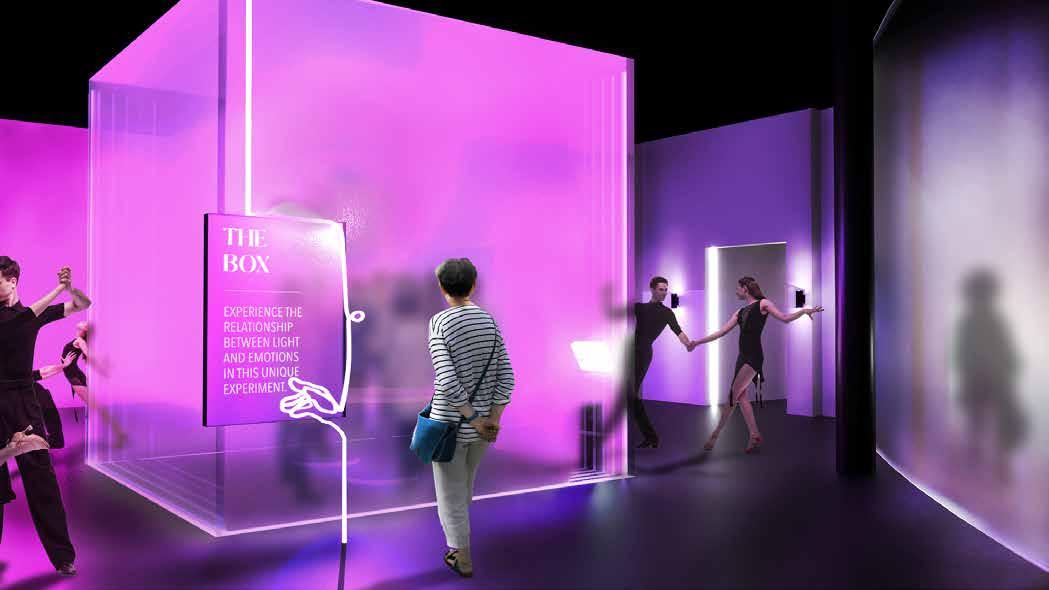
This area introduces visitors to the relationship between light and emotions. They are welcomed by a giant glass box in the middle of the room, with dancers around it. Upon entering the box, they find two touch tables—one with the interface of a color wheel to control hue and the other with bars to control brightness and saturation. They can take turns to play around with it, and what they’ll see is that their lighting changes affect the music and mood of the performance taking place outside of the box.

This section taps into some properties of light, such as reflection, refraction, light, and shadow. Visitors get the opportunity to create their own light installation using light paintings by artist Stephen Knapp, who uses refraction of light to create magnificent artworks. They also watch a shadow dance performance and indulge in an engaging activity that focuses on how light and shadow can completely transform your facial features.


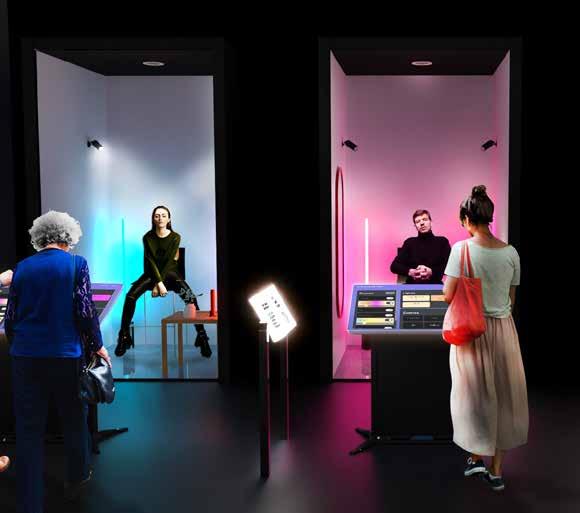
The power we hold is an area where the visitors really get to apply what they learnt. There are three booths with performers sitting still as models, one in each. The visitors are given instructions to create their own lighting scene in each of the booths, putting them in the shoes of lighting designers. They get the opportunity to control which lighting fixtures will be on in each scene, along with setting the color, temperature, and brightness to create a holistic picture.,


Before entering the branded section, they have one final activity in the form of a quiz where they answer a few pictorial questions to get their ‘lighting personalities.' These personalities represent the three major categories of lighting—ambient luminescence, focal glow, and play of brilliants. Depending on the personality type, visitors get either a purple, orange or teal ticket; which they take with them into the final activation.

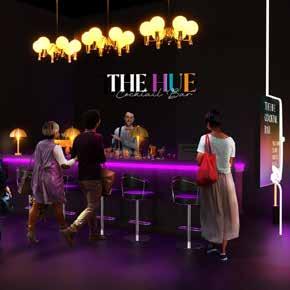

This is the branded section of the exhibit. Here’s where the client Philips Hue really comes into play. Visitors are welcomed with a beautiful cocktail bar, where they can redeem their colored tickets for a personalized drink that matches that personality type. After taking their drink, they move on to the grand product display that mimics the external facade with the windows, creating a moment of recollection of the outside experience.
Philips Hue staff warmly welcomes visitors to test and try different products, with the option to purchase them at one of the self–checkout kiosks or take a product catalog home.
Lastly, visitors are drawn to the Philips Hue photo booths, where they have the ability to control the lighting and take stunning pictures for their social media or memories, so that this experience can stay with them forever.





AN INTERACTIVE THEATRICAL EXPERIENCE

JANUARY 25 – MARCH 20, 2024
477 BROADWAY, NEW YORK, NY

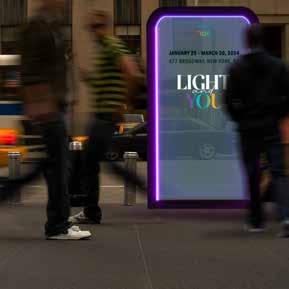
Interactive panels that look like ‘windows’ appear on the streets of New York City. These panels have motion censors, so when someone comes up to them or tries to interact with them, the light and tint of the glass changes. Not only does this let you see the world through that tint, but also spreads awareness and delivers information about the exhibition.
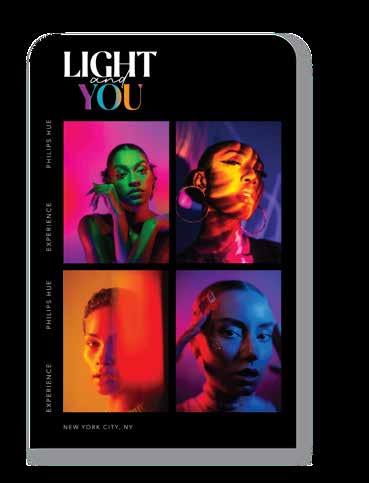


I am born and raised New Yorker and an artist and designer with a graduate degree in Exhibition and Experience Design from Fashion Institute of Technology (FIT).
Since completing the undergraduate degree at Skidmore College I have been working in all spheres of the art world. I have curated and produced both group and solo shows in addition to providing business and coaching support for emerging artists.
I am passionate about art and design. I enjoy creative problem-solving, especially concept development, and I am looking to work with similarly enthusiastic artists and designers.
My inspiration for this project comes from my previous experience in fine art exhibition and sales. Being both a curator and collector has afforded me a front seat to a variety of visitors, collectors, dilettantes, dabblers, dealers, and sellers all with different motivations and philosophies. If there is one thing these disparate groups can come close to agreeing it's this—while the white cube gallery model serves a purpose, it does not serve everyone, and that's where exhibition designers come in.
Engaging with art is highly personalized and identity affirming practice that is too often subject to larger trends and whims of the art market. Instead, spaces should be designed to encourage visitors to feel more confident in their subjective assessments and personal tastes.
The first challenge we face is simply getting people in the door. For that reason I've chosen a venue that is not Chelsea gallery space, but isn't too dissimilar. Some aspects of the exhibition will look a bit like a white cube gallery, but the way the visitor engages with them, especially with the help of interactives, programming, and knowledgeable facilitators, will change experience entirely.
In an effort to make gallery space more inviting, inclusive, and participatory Find Your Missing Piece of Art will employ exhibition design methods and conventions that are traditionally found in children's museums, science centers, and history museums. Interactive activations, often with an emphasis on learning, affording the opportunity to provide feedback, or those of co-creation or co-curation create memorable experiences and encourage prosocial behavior.
In providing programming that is tailored to the community and continuing to solicit feedback that will improve that programming, a gallery can create a symbiotic relationship. In maximizing engagement and leveraging their utility to the community the gallery will be able to realize their full economic potential.
Collecting art is an identity affirming practice driven by personal taste and a subjective definition of value however it seems incapable of escaping larger trends of The Art Market. As a result, spaces can be designed to encourage visitors to feel more confident in their individual choices in art, potentially protecting them from external market pressures when purchasing. Fine art exhibitions that incorporate community feedback toward nurturing individuality over market influence can impact both small and large galleries and increase their value to the community. This exhibition explores how this dynamic can occur and creates fun opportunities to give feedback on what can feel like a serious or inaccessible topic to some.
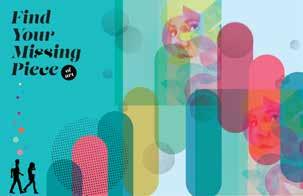

Creating art, and by extension collecting art, is identity affirming and a way of perpetuating culture, tradition, heritage, and personal legacy.
Because engaging with art is highly personalized, one measure of a successful art experience is whether or not it affords space for consideration as opposed to offering a prescribed view.
Client
Venue
Audience
Creative Time
Highline Stages
Primary: Art buyers
Secondary: Art enthusiasts
Your taste in art is a reflection of who you are, an extension of yourself, and a unique point of view to be celebrated.


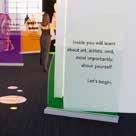
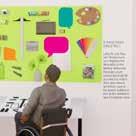




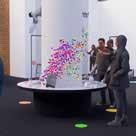
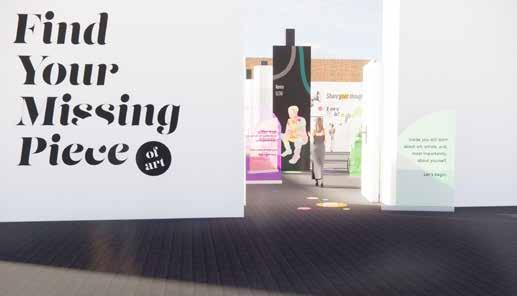

SEE: Introductory panels priming the visitor for the experience: What do you expect when you attend an art event or exhibition? What makes you happy? How are you feeling right now?
DO: Take a moment to ground yourself and check in—honest reflection is an important part of the experience.
EXPERIENCE: Yourself, the space, and your reaction to the space and the introductory text.
LEARN: This is meant to be an enjoyable and highly personalized experience, enjoy.
SEE: One painting on the wall with a chair in front of it and a divider separating it from a similar set up.
DO: Sit (or stand) and take in the painting in front of you for one minute. (After one minute a light will pulse and a gentle tone will suggest you move to the next seat and repeat the process three more times).
EXPERIENCE: Experience the work of art in front of you. Be present, experience your response to the work. Let your eyes wander and see where it takes you. Identify something pleasing or discordant in the work.
LEARN: How did you feel? Did it make you feel an emotion? Did you recognize something or did it make you recall something from your past? Could you imagine the work in your home? Would you want to? Did repeating the process change it for you?










SEE: A pegboard wall divided in four columns -one for each of the paintings from the previous section. Three types of hang-tags stating “Love It!, Leave It, and Lukewarm.”
VINYL DECALS SHOWN HERE IN CLUSTER DISTRIBUTION INDICATIVE OF EXHIBITION AREAS & RELATE BACK TO EXTERIOR WAYFINDING GRAPHICS. AN ASSORTMENT OF VINYL CIRCLES WILL BE ORDERED WITH THE FOLLOWING VARIABLES: BRAND COLORS; 4 SIZES (24"; 15"; 10"; 5"); INDDOR & OUTDOOR VINYL. REFER TO EXHBITION MODEL PHOTOGRAPHS FOR PLACEMENT AT TIME OF INSTALLATION.


DO: Visitors may leave low-lift feedback on any or all of the artworks. If so inclined, and particularly if they have chosen “Lukewarm” visitors are encouraged to write in supplemental qualitative feedback. *Provides aggregate data for research.
CLUSTERS SHOULD LEAD TO INITIAL TOUCHPOINT OF ACTIVATION AREA, UP THE WALL TO INTRODUCTION OR AREA DIRECTIVE.



EXPERIENCE: As the first co-authored feedback experience this interactive is intentionally straightforward and helps establish the participatory tone. Visitors should feel their opinion is valued but voluntary and they may move at their own pace.
LEARN: This is a safe space to express different opinions. It’s completely valid to not like a work of art, or to like a work of art as a gift for someone you know, or, as we’ve said before, to not know exactly why—we’re learning!






profession, learn
SEE: Two three-sided columns in the space with a high resolution printed graphic panels featuring each of the six exhibiting artists, a single cup handset, and (what appear to be) three buttons with the directive “Play Here.”
DO: Each column face is a silhouette of the artist with their work masked inside. There can be other items and personal effects around the silhouetted portrait but the focus is on listening to the first-person audio recording of the artists speaking about their studio practice, techniques, and what matters to them.
A virtual meet and greet for when the artists are not available and the ability to “dialogue” with the artist on their terms. It is a no-stakes opportunity for a visitor to make a personal connection with an artist and possibly decide to be a supporter or collector.
KEY PLAN
LEARN: Learn more about art as a practice and profession, learn more about each of the exhibiting artists, and, as with many of the interactives in this exhibition, learn more about yourself and your own tastes. Something from your past? Could you imagine the work in your home? Would you want to? Did repeating the process change it for you?
DRAWN BY: CAMERON LEDY
SCALE: A S INDICATED
SCALE: A S INDICATED
DATE:
DATE: DEC. 8, 2023
DRAWING NAME:
DRAWING NO:
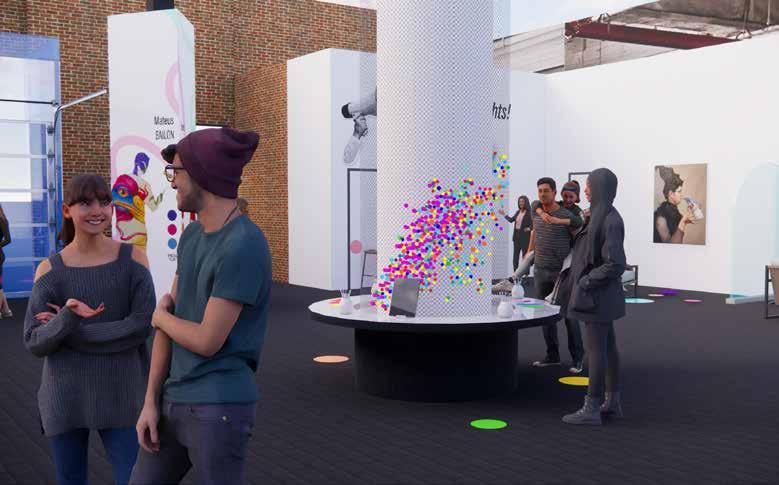
SEE: The central column has a sheath of wire mesh and a circular writing desk at its base. Color-coded sheets of paper are printed with a range of emotions and descriptors such as "happy, inspiring, conversation starting, anxious," and more.
DO: Visitors are asked " What did you feel today?" and given space to elaborate on whatever aspect of the experience provoked a response—positive, negative, or neutral. The pieces of paper are rolled up and placed in the slots of the wire mesh and when the reachable holes are filled, the mesh sheath is raised up the column.
negative, or neutral. The pieces of paper are rolled up and placed in the slots of the wire mesh and when the reachable holes are filled, the mesh sheath is raised up the column.
EXPERIENCE:
Your opinion matters. In this space we want visitors to feel comfortable sharing their thoughts and opinions. Additionally the experience of sharing your opinion should be fun, friendly, and beautiful.
EXPERIENCE: Your opinion matters. In this space we want visitors to feel comfortable sharing their thoughts and opinions. Additionally, the experience of sharing your opinion should be fun, friendly, and beautiful.
LEARN:
Visitors will literally see how different opinions and experiences come together to create something beautiful. In addition to being a whimsical co-created paper sculpture the Feedback Column is a form of Data Visualization providing a temperature check on sentiment and attendance throughout the show.
LEARN: Visitors will literally see how different opinions and experiences come together to create something beautiful. In addition to being a whimsical co-created paper sculpture the Feedback Column is a form of Data Visualization providing a temperature check on sentiment and attendance. throughout the show.






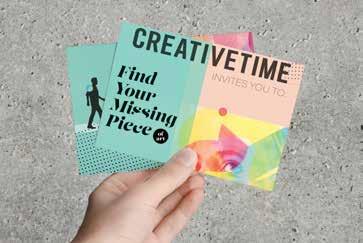

Caroline Siavichay is an exhibit and experience designer based in New York City. Her work explores the intersection of design, education, connection and culture. Her background is in theatre performance and she received a BFA from Virginia Commonwealth University before becoming an award-winning theatrical director and performer. She also spent the summer of '23 as an exhibit design intern at the National Museum of the American Indian, where she learned about best practices when designing for cultural heritage institutions.
As a winner of the 2023 Designing for Empathy Student Award from One Empathy Network, Caroline is passionate about audience connection and the way that storytelling through spatial design creates bonds by highlighting our common humanity.
One of the most powerful forms of intangible cultural heritage is the stories that are passed on through generations, and the way that they are used to carry on cultural sovereignty. While many of these narratives have starred as the central theme or made notable cameos in museum exhibitions over the years, the manner in which they have been told has often followed the same static formula that has dominated the museum field for over a centuryone that glorifies individualism, academia and silent reflection. However, following the intense hit to social wellness brought on by the pandemic of the 2020s, the role of the museum is being reevaluated. There is now a greater emphasis being placed on the need for community spaces that tell these stories of intangible cultural heritage in a way that enriches and honors the surrounding community by encouraging social connection rather than individual, academic isolation.
One of the most powerful forms of intangible cultural heritage is the stories that are passed on through generations, and the way that they are used to carry on cultural sovereignty. While many of these narratives have starred as the central theme or made notable cameos in museum exhibitions over the years, the manner in which they have been told has often followed the same static formula that has dominated the museum field for over a century—one that glorifies individualism, academia, and silent reflection. However, following the intense hit to social wellness brought on by the pandemic of the 2020s, the role of the museum is being reevaluated. There is now a greater emphasis being placed on the need for community spaces that tell these stories of intangible cultural heritage in a way that enriches and honors the surrounding community by encouraging social connection rather than individual, academic isolation.
The applied project is an exhibition for the National Museum of Ireland - Country Life called Heal Harm Protect This exhibition explores the history and legacy of folk customs and beliefs in Irish culture by exploring the “magical” applications of everyday objects in the home according to folk custom and tradition. I selected this subject and museum because I wanted to apply the theory of my thesis in a setting steeped in a culture that places a high value on community connection, commonly communicates historical information through the use of presentation and narrative and has preserved the ancient roots of their cultural heritage through the generational passage of ritual and tradition. Through the design of the exhibition, the application of the thesis theory creates a space that allows visitors to not only learn about Irish culture, but to experience the atmosphere and traditions that make it unique firsthand This allows them to build not only an academic understanding but a socio-emotional one, which fosters empathy and feelings of belonging and connection.
The applied project is an exhibition for the National Museum of Ireland - Country Life called Heal Harm Protect. This exhibition explores the history and legacy of folk customs and beliefs in Irish culture by exploring the “magical” applications of everyday objects in the home according to folk custom and tradition. I selected this subject and museum because I wanted to apply the theory of my thesis in a setting steeped in a culture that places a high value on community connection, commonly communicates historical information through the use of presentation and narrative and has preserved the ancient roots of their cultural heritage through the generational passage of ritual and tradition. Through the design of the exhibition, the application of the thesis theory creates a space that allows visitors to not only learn about Irish culture, but to experience the atmosphere and traditions that make it unique firsthand. This allows them to build not only an academic understanding but a socio-emotional one, which fosters empathy and feelings of belonging and connection.
Modern museums have become more than spaces for academic exploration that solely foster intellectual well-being. These modern institutions have evolved into sacred spaces of community ritual and synergy that are fostering social wellbeing in an unprecedented way. However, this phenomenon of societal cohesion and well-being is going largely underutilized, as many exhibitions are still designed with primarily intellectual learning outcomes in mind. Understanding why and just how deeply the use of museums as ritual and sacred spaces can positively impact the social well-being of a surrounding community gives designers the opportunity to expand the scope of their intended project outcomes to include goals of fostering prosocial behavior and improving societal well-being. Through the sequencing of design elements to strategically include moments of shared group experiences, both synchronous and complementary, interspersed with opportunities for individual rest and reflection, museums can accomplish these goals in order to better contribute to the overall well-being of communities.
Modern museums have become more than spaces for academic exploration that solely foster intellectual well-being. These modern institutions have evolved into sacred spaces of community ritual and synergy that are fostering social wellbeing in an unprecedented way. However, this phenomenon of societal cohesion and well-being is going largely underutilized, as many exhibitions are still designed with primarily intellectual learning outcomes in mind. Understanding why and just how deeply the use of museums as ritual and sacred spaces can positively impact the social well-being of a surrounding community gives designers the opportunity to expand the scope of their intended project outcomes to include goals of fostering prosocial behavior and improving societal well-being. Through the sequencing of design elements to strategically include moments of shared group experiences, both synchronous and complementary, interspersed with opportunities for individual rest and reflection, museums can accomplish these goals in order to better contribute to the overall well-being of communities.



Big Idea
To improve social wellbeing, encourage prosocial behavior and foster community connection by creating a space that gives a sense of ownership and accessibility to local community members while engaging all visitors in a shared immersive experience that inspires empathy and brings the magic of Irish folk customs to life in an unforgettable way.
To improve social well-being, encourage prosocial behavior and foster community connection by creating a space that gives a sense of ownership and accessibility to local community members while engaging all visitors in a shared immersive experience that inspires empathy and brings the magic of Irish folk customs to life in an unforgettable way.
Toimprove social well-being, encourage prosocial behavior and foster community connection by creating a space that gives a sense of ownership and accessibility to local community members while engaging all visitors in a shared immersive experience that inspires empathy and brings the magic of Irish folk customs to life in an unforgettable way.


Client
Client
Client
Subject
National Museum of Ireland - Country Life
Irish Folk Customs and Beliefs in the Home
National Museum of Ireland - Country Life
National Museum of Ireland - Country Life
Venue
Subject Venue
Audience
Subject Venue
Audience
Audience
National Museum of Ireland - Country Life
Irish Folk Customs and Beliefs in the Home
Irish Folk Customs and Beliefs in the Home
Primary: Families & School Groups
National Museum of Ireland - Country Life
National Museum of Ireland - Country Life
Secondary: Professional/Hobbyists, Explorers
Primary: Families & school groups
Primary: Families & School Groups
Secondary: Professional/hobbyists, explorers
Secondary: Professional/Hobbyists, Explorers

Fig. 01
Fig. 01
1: Welcome
Welcome
1. Intro Panel
Intro Panel
2. Welcome Gate
5: Festival
5: Festival
12. Ghost Silhouette Displays
12. Ghost Silhouette Displays
13. Maypole Case Display
Welcome Gate
3. Fairy Path
1: Welcome
Fairy Path
1: Welcome
1. Intro Panel
Village
2. Welcome Gate 3. Fairy Path
2: Village 4. Hidden Objects
1. Intro Panel
2. Welcome Gate
3. Fairy Path
5. Protect Your Home
Hidden Objects
2: Village
2: Village 4. Hidden Objects
Protect Your Home
5: Festival
13. Maypole Case Display
13. Community Objects
5: Festival
13. Community Objects
14. Fireside Seanchai
14. Fireside Seanchai
15. The Tale of Bel
12. Ghost Silhouette Displays
15. The Tale of Bel
13. Maypole Case Display
12. Ghost Silhouette Displays
16. Pepper’s Ghost Magical Objects
13. Maypole Case Display
17. Children’s Craft Area
13. Community Objects
16. Pepper’s Ghost Magical Objects
13. Community Objects
14. Fireside Seanchai
15. The Tale of Bel
17. Children’s Craft Area
14. Fireside Seanchai
15. The Tale of Bel
6: Death
16. Pepper’s Ghost Magical Objects
4. Hidden Objects
The Tale of the Plaisham
5. Protect Your Home
6. The Tale of the Plaisham 3: Marriage
6. The Tale of the Plaisham
5. Protect Your Home
6. The Tale of the Plaisham
5. Ghost Silhouette Displays
Marriage
3: Marriage
6. Community Objects
3: Marriage
Ghost Silhouette Displays
7. Fireside Seanchai
Community Objects 7. Fireside Seanchai
5. Ghost Silhouette Displays
5. Ghost Silhouette Displays
4: Birth
6. Community Objects
7. Fireside Seanchai
4: Birth
6. Community Objects
7. Fireside Seanchai
Birth
4: Birth
8. Ghost Silhouette Displays
9. Community Objects
10. Fireside Seanchai
8. Ghost Silhouette Displays
8. Ghost Silhouette Displays
8. Ghost Silhouette Displays
11. Drawing the Well
9. Community Objects
9. Community Objects
9. Community Objects
10. Fireside Seanchai
10. Fireside Seanchai
10. Fireside Seanchai
11. Drawing the Well
11. Drawing the Well
11. Drawing the Well
17. Children’s Craft Area
16. Pepper’s Ghost Magical Objects
6: Death
17. Children’s Craft Area
18. Ghost Silhouette Displays
6: Death
19. Community Objects
6: Death
18. Ghost Silhouette Displays
20. The Wishing Tree
19. Community Objects
18. Ghost Silhouette Displays
18. Ghost Silhouette Displays
20. The Wishing Tree
19. Community Objects
20. The Wishing Tree
7: The Otherworld
19. Community Objects
20. The Wishing Tree
7: The Otherworld
7: The Otherworld
7: The Otherworld
21. UV Message Divination
22. Fireside Repose
21. UV Message Divination
21. UV Message Divination
23. The Tale of Oisin and Niamh
21. UV Message Divination
22. Fireside Repose
22. Fireside Repose
22. Fireside Repose
23. The Tale of Oisin and Niamh
23. The Tale of Oisin and Niamh
All visitors enter the exhibition in Area 1 either via the staircase or elevator (Fig. 01). From there, the exhibition is designed in a counter-clockwise direction, however the narrative will not be effected by choosing another route. The space is designed to give the impression of winding through a village and getting a look into people's homes on the most important days of their lives. The content is divided by these important days- building a new home, marriage, birth, festivals, death and the afterlife. Content will be delivered in the exhibition through multiple repeated modes of engagement (Fig. 02) that use technology to create a sense of effortless magic in their interactivity. Throughout their experience, visitors will learn about folk customs and beliefs in each content area through the sequence of Reveal, Relate, Revere and Receive (Fig. 03) which serves to make the magic of rural customs relatable to all visitors while revealing just how special and magical they have made these important days in the Irish culture for centuries.
All visitors enter the exhibition in Area 1 either via the staircase or elevator (Fig. 01). From there, the exhibition is designed in a counter-clockwise direction, however the narrative will not be effected by choosing another route. The space is designed to give the impression of winding through a village and getting a look into people's homes on the most important days of their lives. The content is divided by these important days- building a new home, marriage, birth, festivals, death and the afterlife. Content will be delivered in the exhibition through multiple repeated modes of engagement (Fig. 02) that use technology to create a sense of effortless magic in their interactivity. Throughout their experience, visitors will learn about folk customs and beliefs in each content area through the sequence of Reveal, Relate, Revere and Receive (Fig. 03) which serves to make the magic of rural customs relatable to all visitors while revealing just how special and magical they have made these important days in the Irish culture for centuries.
All visitors enter the exhibition in Area 1 either via the staircase or elevator (Fig. 01). From there, the exhibition is designed in a counterclockwise direction, however the narrative will not be affected by choosing another route. The space is designed to give the impression of winding through a village and getting a look into people's homes on the most important days of their lives. The content is divided by these important days—building a new home, marriage, birth, festivals, death, and the afterlife. Content will be delivered in the exhibition through multiple repeated modes of engagement (Fig. 02) that use technology to create a sense of effortless magic in their interactivity. Throughout their experience, visitors will learn about folk customs and beliefs in each content area through the sequence of Reveal, Relate, Revere, and Receive (Fig. 03) which serves to make the magic of rural customs relatable to all visitors while revealing just how special and magical they have made these important days in the Irish culture for centuries.

23. The Tale of Oisin and Niamh Storytelling
All visitors enter the exhibition in Area 1 either via the staircase or elevator (Fig. 01). From there, the exhibition is designed in a counter-clockwise direction, however the narrative will not be effected by choosing another route. The space is designed to give the impression of winding through a village and getting a look into people's homes on the most important days of their lives. The content is divided by these important days- building a new home, marriage, birth, festivals, death and the afterlife. Content will be delivered in the exhibition through multiple repeated modes of engagement (Fig. 02) that use technology to create a sense of effortless magic in their interactivity. Throughout their experience, visitors will learn about folk customs and beliefs in each content area through the sequence of Reveal, Relate, Revere and Receive (Fig. 03) which serves to make the magic of rural customs relatable to all visitors while revealing just how special and magical they have made these important days in the Irish culture for centuries.

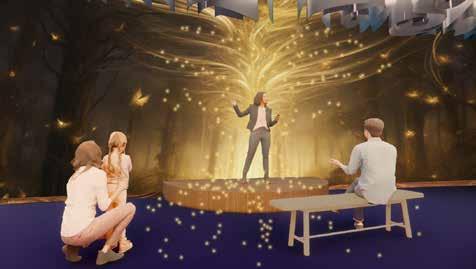


Storytelling Performances - performances of traditional Irish folktales brought to life with projection mapping
Storytelling Performances - performances of traditional Irish folktales brought to life with projection mapping
Ghost Display Cases - projected silhouettes that are meant to represent the ghosts of the original owners of the artifacts interacting with them as they would have on these special days
Ghost Display Cases - projected silhouettes that are meant to represent the ghosts of the original owners of the artifacts interacting with them as they would have on these special days


Community Objects - opaque smart glass cases containing items collected from the local community. When activated, the cases become transparent and a first person narrative about the object plays
Community Objects - opaque smart glass cases containing items collected from the local community. When activated, the cases become transparent and a first person narrative about the object plays
Fireside Seanchai Booths - visitors respond to a prompt by recording their own short story that will later be shared with another visitor
Fireside Seanchai Booths - visitors respond to a prompt by recording their own short story that will later be shared with another visitor
The experience begins on the museum grounds where we see wayfinding structure inspired by the folklore of the will-o'-the-wisp, which leads lost travellers. In their inactive state, the wayfinding structures will appear to be semi-transparent blue glass orbs. As visitors approach, the orbs will be activated by motion sensors that turn on the internal illumination and reveal the gold writing that provides information about the location and dates of the exhibit.

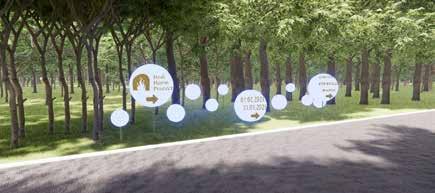
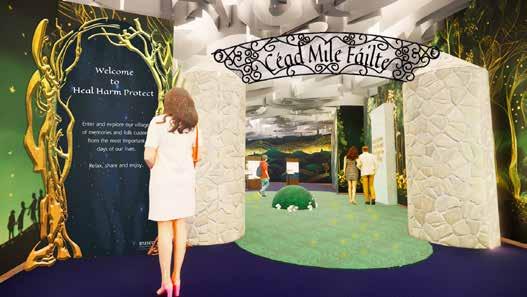
Upon entry, visitors will see the introductory panel to the left, which will give them a basic overview of the exhibit and help them to easily identify the entry. They will also see a large iron welcome sign over the entry supported by two stone pillars, which makes reference to the stone and iron gates of the rural Irish fields. Beyond the gates, they will see the “field area” marked by interactive LED flooring and a small “fairy hill.” On the mural covered walls of this area there will be signage that teaches visitors about the folk custom of avoiding building homes wherever there is a “fairy path,” where it is said the fairies cross during the night. These fairy paths are made visible by gold illuminated footprints left by visitors on the interactive flooring, which places visitors into the narrative of the exhibit by informing them that no village can be built in this area and we must search for land with no fairy paths.


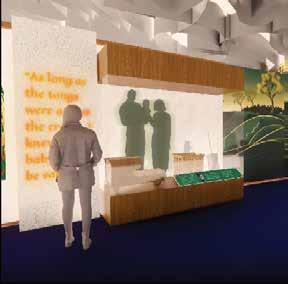
The content is organized around special days in the life of a home, divided into categories of building a new home, marriage, birth, festivals, death, and an afterlife journey to the Otherworld. Each area is anchored by stories and interactives that both show visitors how special days are celebrated in Irish culture and invite them to share their own special cultural memories and reflections. Pictured here are the Village, Marriage, and Birth areas.


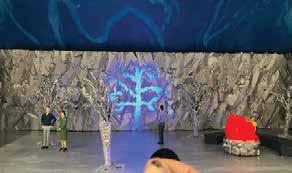
The content is organized around special days in the life of a home, divided into categories of building a new home, marriage, birth, festivals, death, and an afterlife journey to the Otherworld. Each area is anchored by stories and interactives that both show visitors how special days are celebrated in Irish culture and invite them to share their own special cultural memories and reflections. Pictured here are the Festival, Death, and Otherworld areas.

The visual identity system is based on using natural elements in a way that exposes the hidden magic within them. The poster also highlights the idea of community ownership and a sense of cultural collection and belonging for all who visit.
The visual identity system is based on using natural elements in a way that exposes the hidden magic within them. The poster also highlights the idea of community ownership and a sense of cultural collection and belonging for all who visit.
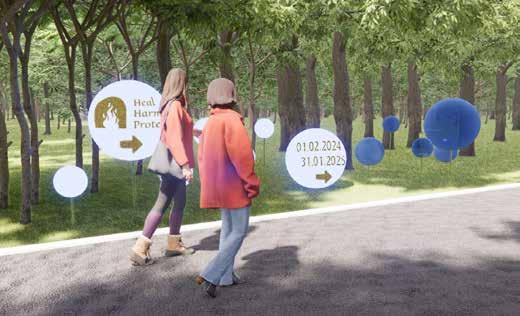
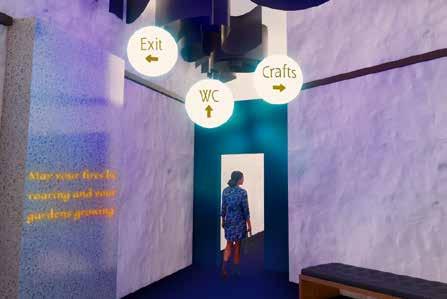
The wayfinding system is based on the folklore of the will-o'-the-wisp, an atmospheric ghostly light that appears to travellers in Ireland and leads them towards their destination. This is manifested in the exhibit design by blue orb lights with gold, glittering text and arrows that serve as directional wayfinding. Exterior wayfinding is motion-sensor activated, while interior wayfinding is
The wayfinding system is based on the folklore of the will-o'-the-wisp, an atmospheric ghostly light that appears to travellers in Ireland and leads them towards their destination. This is manifested in the exhibit design by blue orb lights with gold, glittering text and arrows that serve as directional wayfinding. Exterior wayfinding is motion-sensor activated, while interior wayfinding is

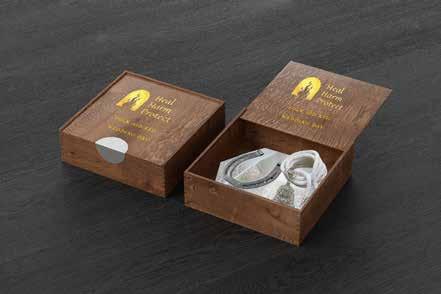
Fireside Seanchai: The Tale of a Friend: After recording their story, visitors will get a QR code that will allow them to listen to another visitor's story after their visit. This communal sharing of stories encourages empathy and social connection.

Folk-Aid Kits: Visitors can purchase small kits filled with items from local makers and artisans that contain all of the items needed to engage in good fortune folk rituals on the special days in their lives.

Seasonal Rituals: Throughout the year, rotating individual folk rituals based on the seasons will be available. For example, pictured here is the Winter Solstice Candle ritual which is all about bringing light back to the darkness.
Quarter Festival Public Celebrations:
• Opportunity for relationship building within community
• Imbolc - Feb 1st
• Beltane - May 1st
• Lughnasadh - August 1st
• Samhein - October 31st
• Food, music, games, raffles

D. is a Certified Interior Designer and has been practicing in NYC for 15 years. They are an expert in materiality, furnishings, and space planning, and have extensive experience in client relations, sustainable design, detailing, and project management. They have a BFA in Interior Design from FIT, and went on to teach in that very program. D's first article, “Using Experiential Design To Improve The Patient Experience,” was published by Healthcare Design Magazine in August 2023.
D's background in advocacy brought them to this program, their desire to leverage design to create meaningful work to make people think, to make people feel, and to make them look at how they treat themselves, others, and their planet. They design to make people’s lives better, to make them think in new ways, and to ensure the stories that need to be told are put out into the world with care, love, and empathy, using my own voice and skills as a conduit to advocate for others.
This thesis outlines a framework for fostering meaningful dialogue between all Queer people, not just homosexual identities. This dialogue has the power to heal rifts between Queer groups by fostering dialogue between differing individuals. It is clear that Queer people, regardless of specific sexual or gender identity, bear struggles their cishet counterparts do not. Creating forums for simply sharing stories allows Queer people to identify with the unique struggles of others by relating them to their own experiences. This sharing builds empathy for the individuals involved and fosters connectivity.
The Rainbow Connection explores the themes of belonging and self-acceptance before applying these themes to broader community acceptance and belonging. The Rainbow Connection, the experience for which the exhibition is named, is where the title becomes clear. Literally, this place brings together broad ranges of identities to meet and connect two at a time. A oneon-one conversation between participants centered on curated objects provides the seeds of discussion and means for those seeds to take root. The experiences following it are designed to allow these roots to spout, spread, and blossom.
Through discussion of Queer individuals throughout history, light is shed on what we know, suspect, and will never be able to determine, creating a sense of loss for the past. Introducing discussion of identity and sharing stories of those many identities nurtures the desire for future growth, encouraging people to take even a small amount of this experience with them.
The proposed exhibition project, “In-Sync: Foster Movement Synchrony in the post-pandemic work culture” applies the key themes explored in my thesis to a built environment set in St. Ann’s Warehouse, in Dumbo, Brooklyn. Throughout the exhibition, the audience is able to reflect, remind, engage and embody the theory of Movement Synchrony.
The adaptation and integration of these practices and narratives into the exhibition experience create new perspectives and meaningful social interconnection vital to the new norm.
The expansion of the Queer community since the inception of the Queer rights movement has led to culture gaps and fracturing among differing Queer social groups. Rebuilding the connections between these unique groups would give Queer people insight into others as well as themselves. Fostering unity in this way can galvanize the community at large, while at the same time, addressing systemic internal phobias, deepening an individual’s sense of self, and reinforcing empathy with the struggles of others. Thought-provoking, educational spaces that welcome conversation among broad demographics of Queer people have the power to build community through discussion of Queer history and mental health.



710,000,000 Queer People
710,000,000Experiences
Approaching The Center, visitors will see an undulating 11-striped rainbow ribbon, the Rainbow Path, a wayfinding device and a decorative element that visually guides participants through the journey. After being greeted, participants will come face to face with their own Queerphobias, learn about both the victories and injustices the community has faced, and then engage in a one-on-one conversation with another person whom you do not know. The pair will receive a collection of objects to discuss and are given prompts that lead them to form meaningful dialogue. The areas following this are highly participatory and will provide content to seed conversations while encouraging guests to share and listen. The rainbow path will guide participants back to the welcome area, where they will be asked to complete one final task: welcome the next person who walks through the door as warmly as they were welcomed.
Approaching The Center, visitors will see an undulating 11-striped rainbow ribbon, the Rainbow Path, a wayfinding device and a decorative element that visually guides participants through the journey. After being greeted, participants will come face to face with their own Queerphobias, learn about both the victories and injustices the community has faced, and then engage in a one-on-one conversation with another person whom you do not know. The pair will receive a collection of objects to discuss and are given prompts that lead them to form meaningful dialogue. The areas following this are highly participatory and will provide content to seed conversations while encouraging guests to share and listen. The rainbow path will guide participants back to the welcome area, where they will be asked to complete one final task: welcome the next person who walks through the door as warmly as they were welcomed.
The American LGBTQ+ Museum & The Generations Project
The American LGBTQ+ Museum & The Generations Project
Subject Venue Audience
Subject Venue Audience
Queer Connectivity and Empathy
Queer Connectivity and Empathy
Originating at The Center, NYC, and traveling to 14 other community centers
Originating at The Center, NYC, and traveling to 14 other community centers
Queer identified adults and their loved ones
Queer identified adults and their loved ones


SEE: a colorful, bright welcome area, and smiling staff.
DO: interact with staff, graphics, and other participants to get an overview of the exhibition
EXPERIENCE: a moment of joy and welcome, shared with staff and other visitors.
LEARN: what to expect while exploring the exhibition


SEE: a dim, spooky, cavernous space with limited visibility.
DO: explore exhibits leveraging lenticular graphics, objects, Pepper’s ghost, digital media, and large scale graphics to poke fun at our biases.
EXPERIENCE: what appears to be a haunted house, but upon exploring, reveals itself to be a playful lesson on bias.
LEARN: gain insight into your own biases while at the same time coming to understand others who are marginally different.
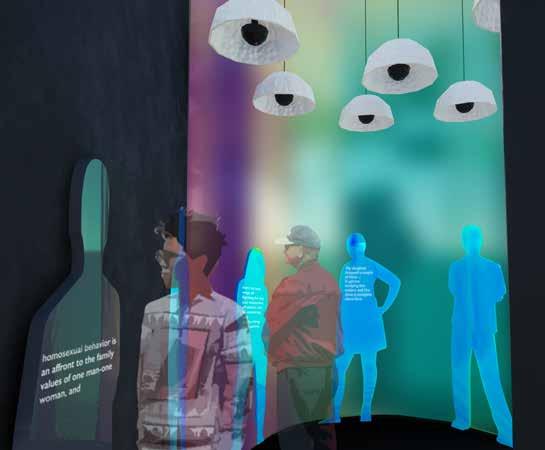
SEE & HEAR: a dark room with silhouettes of people that appear to be speaking.
DO: interact with the silhouettes, which will speak and display their words as you approach them
EXPERIENCE: a diversity of opinions on Queer culture as well as redemption stories
LEARN: about the various biases the cishet population holds, as well as what can prompt people to change their minds
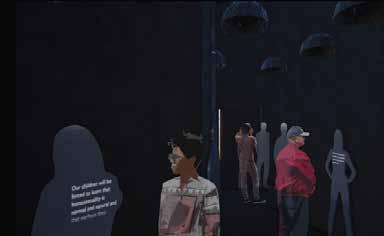
SEE: a traditional courtroom populated with non-traditional “defendants”
DO: explore important Queer objects that have stories to tell about political oppression and overcoming it.
EXPERIENCE: object theater where objects become the first person narrative accounts of historic events, speaking to what they witnessed.
LEARN: how Queer people have been oppressed by government and how the obstacles have been overcome, or how we still struggle with them.
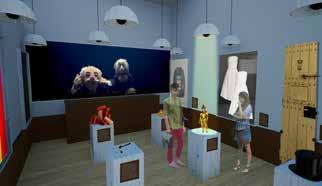

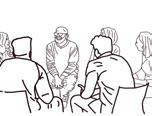





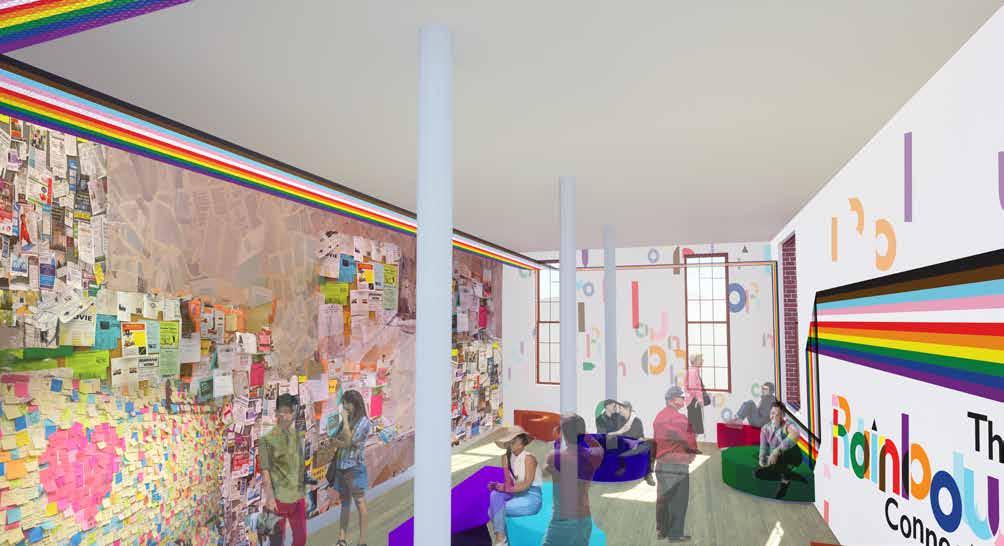
SEE: a bright, sunny, colorful, welcoming space with lounge seating, refreshments, and a message wall
DO: share thoughts about the exhibition, or experiences outside of it
EXPERIENCE: a bright, sunny, colorful, welcoming space to sit comfortably and reflect upon your experiences.
LEARN: what you and others have gotten out of the exhibition
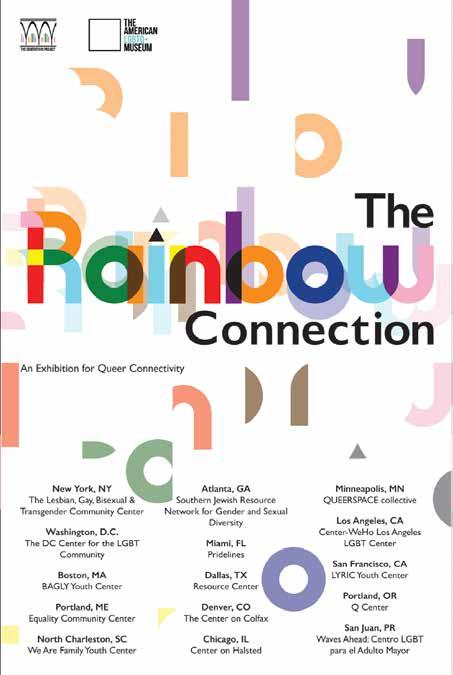

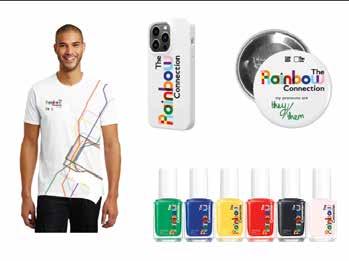

Emily Tse is from New York and resides in suburban Long Island. She obtained a B.E. in Biomedical Engineering at SUNY Stony Brook University. In pursuit of a design career, she completed an associate degree in Communication Design at SUNY Fashion Institute of Technology. Continuing her studies, she then completed a M.A. in Exhibition and Experience Design.
In the exhibition and experience design program, Emily studied branded experiential marketing, museums, trade shows, environmental graphics, and wayfinding signage. She was awarded a student scholarship from the Society for Experiential Graphic Design for her video showcasing SEGD's Xlab event in 2022. The key takeaway of the video was design Studio HHH's demonstration on how art prompts conversation.
Humans have biases, both unconscious and conscious. Unconscious biases unintentionally seep into technology. This technology is deployed globally. It is used in high-stakes situations that determine how likely someone is to be hired for a job, and how likely someone is to be stopped by an officer on the street.
Facial recognition technology is a powerful tool. It is used by the law enforcement to find missing children, uncover firearms, trafficking, and identify suspects of shootings, sexual assaults, and child sex trafficking. Additionally, facial recognition is a tool used to reduce medical errors—the third leading cause of death in the US. It can detect early symptoms of stroke by analyzing facial features.
Advocacy organizations have made huge steps toward public awareness of biases in algorithms. Researcher Dr. Joy Buolamwini started her non-profit Algorithmic Justice League (AJL) back in 2016 when she was a graduate student at MIT. She has been working with legislators to get regulations on facial recognition. In addition, the American Civil Liberties Union (ACLU) and Big Brother Watch in the UK actively defend privacy rights against facial recognition systems. The efforts from advocacy organizations protect people’s right to privacy against facial recognition software. Simultaneously, exhibitions can encourage people to join conversations about AI ethics. They can inform the public about present provocative issues.
This thesis exhibition project applies participatory museum techniques to create an inviting space for everyone to be a stakeholder in facial recognition technology. Visitors are encouraged to share their feelings and experiences with the technology. Role-play and workshop programming are methods to keep visitors engaged in the conversation about algorithmic justice.
Our unconscious biases have been a problem in the past, present, and now in the upcoming future. These biases—racial bias, gender bias, and age bias—perpetuate discrimination in facial recognition technology.
The exhibition “Artificial Minority” will bring public awareness to AI ethics, which will encourage responsible research and application. Participatory museum techniques, such as role-play and workshop programming, will provide ways to spark dialogue and foster awareness of current provocative issues.


Artificial Minority” encourages visitors to understand individuals whose lives were affected by facial recognition technology both positively and negatively. It reveals the repercussions of biased AI, but it also explores the potential of facial recognition to improve people's quality of life and the efforts underway that combat unethical AI.
Every technology is a double-edged sword.”
— Dr. Fei-Fei Li

Diaries of people who were positively and negatively impacted by







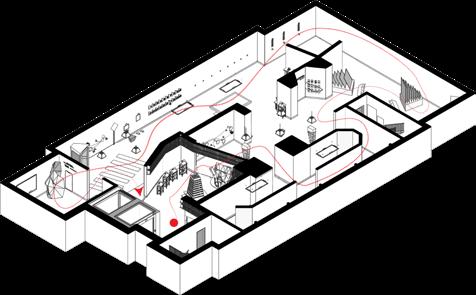
Visitors navigate through seven key areas to learn about algorithmic bias in facial recognition tech. Afterwards, they go to everyday activities, public trust, human experience, bias-busting, road block, and finally real-world impact.
Client National Institute of Standards and Technology (NIST)
Subject Algorithmic justice in facial recognition technology
Venue Cooper Hewitt, Smithsonian Design Museum

Audience High school students, college students, and adults


Shining light on unconscious biases The aluminum spotlight sculpture represents the goal of the exhibition, which is to spread public awareness of biases in algorithms. These include not only computational bias, but also human biases such as confirmation bias and age bias.
Visitors take a personality quiz to adopt a fictional persona with an occupation of a police officer, teacher, lawyer, or journalist. With an RFID tracker, they scan their tag at kiosk stations and read and reflect on diaries from people impacted by algorithmic bias.
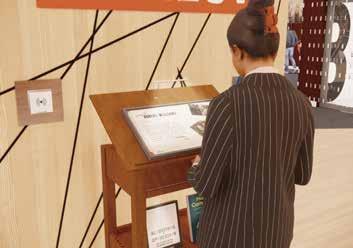

Read and Reflect on diaries of people impact by the technology positively and negatively Throughout the exhibition, there are three kiosk stations where people read diaries and write how they feel and how their persona would feel in response to the stories. This would encourage empathy building and thinking from another person's perspective.
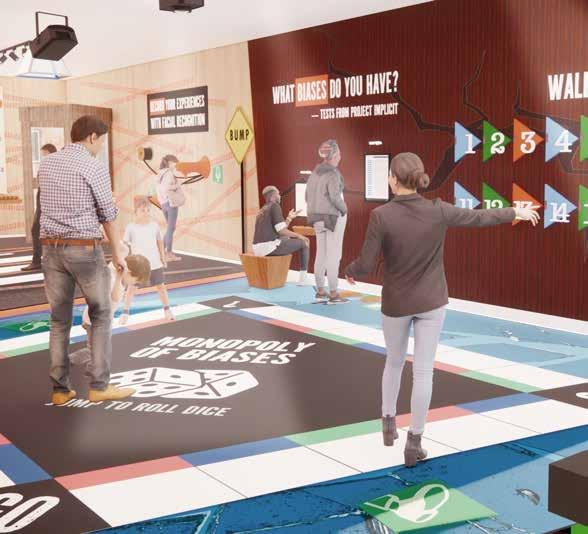
Bias Busting Visitors play Monopoly of Biases to learn about human biases such as similarity bias and conformity bias. They also take implicit bias tests to witness their own age, gender, and race biases. At Pantone’s 110 skin tone shades wall, they match their skin to one of the 110 shades of push pins and place it on the cork board map. They are able to see that people from the same area can have varying skin tones, hence algorithmic injustice favoring lighter skin tone is a global issue.





Visitors collaborate in a team to brainstorm an idea for an AI startup. They are guided by the projected directions to follow a responsible AI workflow developed by the Museum and AI Network in 2019. They would answer questions such as “Is there potential bias in the dataset?”

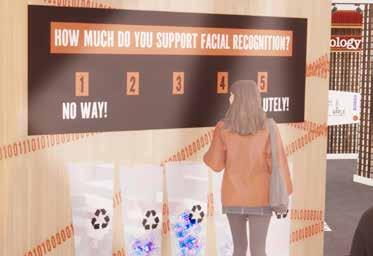
Record your own experiences with facial recognition
Visitors type their experiences with the technology and their responses are projected onto the floor They can also plug in the megaphone cables to activate recording devices and share their stories. At the exit, visitors vote for how much they support the technology by recycling their RFID card in the voting bins.
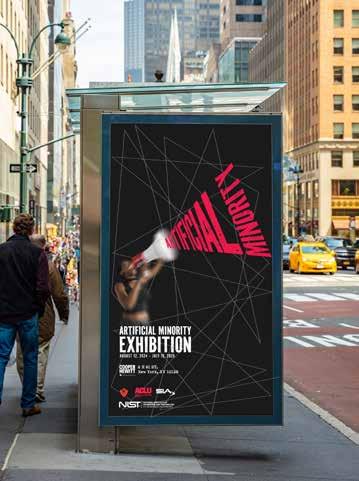

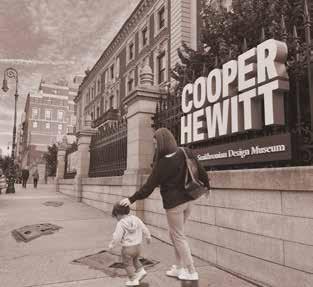






IF YOU HAVE A FACE, YOU HAVE A PLACE IN THE CONVERSATION ABOUT AI.
— DR. JOY BUOLAMWINI



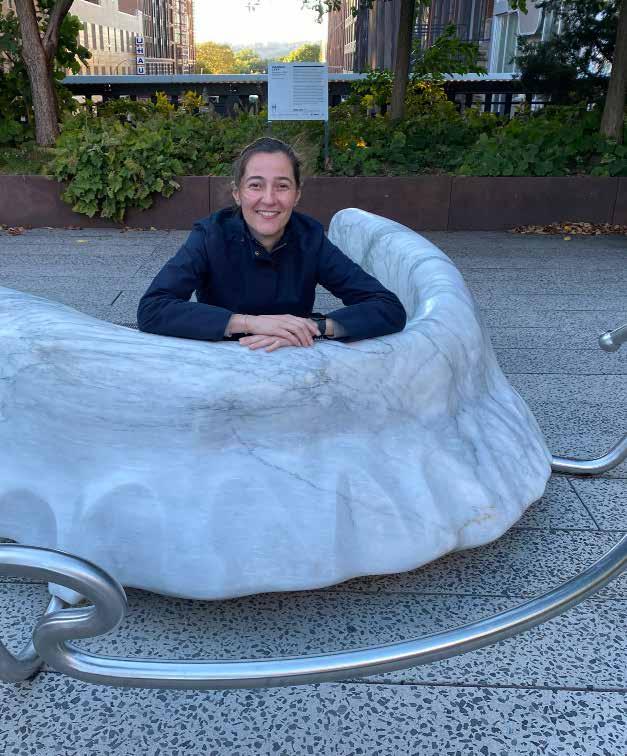
Before I started my studies in architecture, I had a degree in dentistry. As a dentist, I learned about empathy, patience, and tolerance among other hands-on skills. Later on I began studying architecture from a more mature and advanced intellectual development. In architecture, I have learned how the elements that compose an environment can speak to one another to limit space and how to intertwine the interface between different materials. Another academic experience that opened my eyes regarding how cultural differences can be enriching was a course in Japanese architecture that I took in Japan.
Being born in Brazil has allowed me to develop a very particular aesthetic sense. As a country of contrasts, it couldn't be more different in architecture. New York is a city where everything is possible and where people come to reinvent themselves. In addition, it represents the chance to build my own identity, strongly connected to my professional maturity. My intention is to hone the values I already have through consistent choices, based on the collective well-being in terms of sustainability.
When I began my studies in exhibition and experience design, I had the opportunity to explore the relationship between circulation in environments designed and thought around cognitive and community experiences; after all, the museum environment provides different experiences from those offered by a home. Understanding the behavioral patterns of circulation in an exhibition environment allows the designer to make conscious choices related to the layout of exhibition elements and space that are more in line with their intentions. Practically, it means that the greatest possible number of visitors will take time in each section of the exhibition without prioritizing one particular section.
The chosen location was Park Avenue Armory, as it has a large space without compartmentalization besides a high ceiling due to the metal arches. A space without fragmentation let me explore the environment more freely and thus explore design strategies. The research carried out on behavioral patterns allowed me to use design tools such as open plan, depth of field, colors, shapes, scale, and visitor participation, among others. To explore circulation, I chose horses and equine therapy as the theme. The relationship between humans and horses goes back many years. It was a partnership that was built and developed along with our evolution. It helped shape the planet geopolitically and today the horse is widely used for sporting and healing purposes through equine therapy. The main theme of the exhibition is horses and equine therapy, and the exhibition is divided into two groups. The first group is how horses shape the world, through great warriors, WWI, and Arts, while the second group addresses more contemporary themes such as German practices like the control carried out by the German state, the equestrian billiondollar industry, and finally a case study on a Swedish stable that seeks a partnership with a Dutch university to develop sustainable equestrian practices.
Navigating and orienting oneself in an exhibition are activities that can occur concomitantly or not, depending on the level of familiarity that the user has with the environment. Usually, when the visitor is open to exploring the space in a democratic way, they are more susceptible to behavioral patterns that assume individualistic preferences, allowing intrinsic elements of the exhibition to influence the path taken. Exactly there lies the opportunity for designers to affect a visitor's decision-making. Designers can strategically position elements such as displays, artwork, and text to create a hierarchy to explore the potential for spatial attraction.

I n this applied thesis, I investigate the behavioral patterns of visitors through the theme of horses and equine therapy. Simply interacting with a horse has the potential to positively impact people’s lives. The recognition of qualities in the horse gave rise to Equine Assisted Therapy: a practice that understands the horse as a healthpromoting agent. Providing the horse with quality of life is essential for building a relationship of mutual benefit, as well as an opportunity to repay all the good that the horse has provided to humanity. This is Horsecentrism, a mutually beneficial relationship between humans and horses. The Horsecentrism exhibition aims to publicize and make the practice of equine therapy accessible, as well as beneficial practices for the horse.
Client Subject
Venue
Audience
PATH International & FN
Horses and Equine Therapy
Park Avenue Armory - Wade Thompson Drill Hall
Primary: Local and international tourists.
Secondary: People who are directly involved with horses, such as equine therapy professionals, professional riders, and amateurs. People who provide any service to the welfare of horses.
Tertiary: Horse lovers.
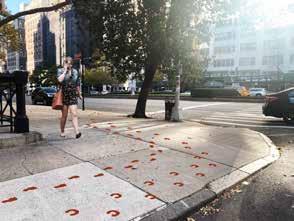



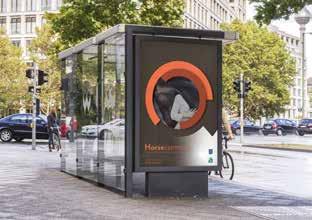



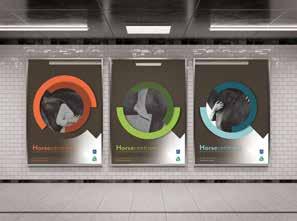


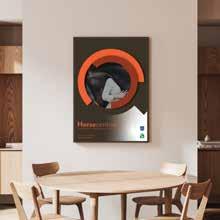

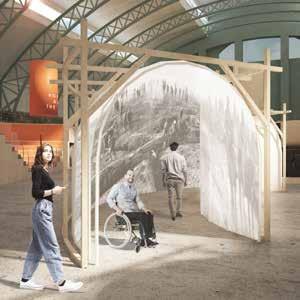
Next to Armies and Warriors is the First World War Tunnel, which consists of a circular tunnel with three entrances made of fabric. The exterior of the tunnel is surrounded by a thin wooden structure that resembles the idea of trenches. The tunnel is divided into three parts: the participation of the horses before, during, and after the war, videos and sounds narrating these moments are available to visitors when walking through the tunnels. It is an immersive experience so that visitors will understand the role of horses in the First World War, and consequently have empathy for the work carried out by horses.
Horses and The Arts area has three activities that take place in an amphitheater. The first is War Horse Performance, a show that uses life-size horse puppets, which are manipulated by at least three actors. The second activity is Cave Paintings of horses, which take place under the bleachers. It consists of a semicircular tunnel that has extruded drawings of horses made in caves on one side, and on the other side, there is paper for people to make their own drawings of horses. The third activity is Life-Size Horse Puppet Workshop, which takes place on the opposite side of the amphitheater stage, where four puppets, identical to those used in the War Horse Performance, are available to visitors so they can manipulate them. Visitors will learn about horses’ body language.
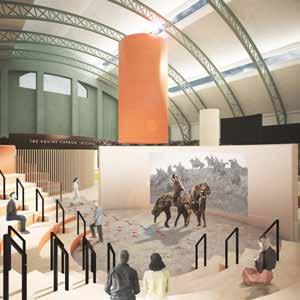
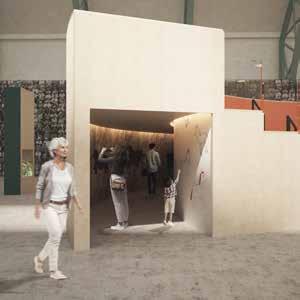


The Equestrian World also has three activities. The first is What Horses Can and Cannot Eat. The objective is to get eight of the sixteen available foods right first. Participants take turns and they must take the food from the wall, scan it in the horse’s mouth and place it back. The second activity is Horses in Motion. The objective is to reproduce the horse’s gaits: walk, trot, and canter, in that order, using the hands and feet. Whoever manages to reproduce the movements first wins. The third activity is Grooming the Horse. The visitor learns how to clean the horse, using the correct tools and movements, in the correct sequence. All three activities seek to teach visitors how to handle horses, and the appropriate foods, in addition to understanding the horse’s mechanics, which is extremely important when practicing sports.
In A Billion-Dollar Industry area, visitors will see six vertical rectangular elements made of fabric positioned in a circle. Each element represents an area of the equestrian industry: food, equipment, instructors, veterinarians, farriers, and horse breeders. Videos about the economic activity will be projected in each element. Through this information, visitors will be able to understand how economically relevant the equine industry is, representing 2.6 billion Euro per year in Germany alone.
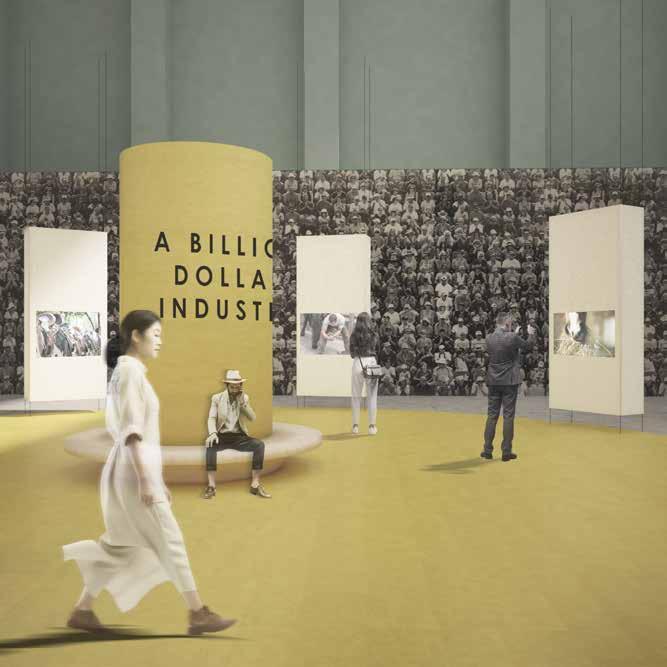
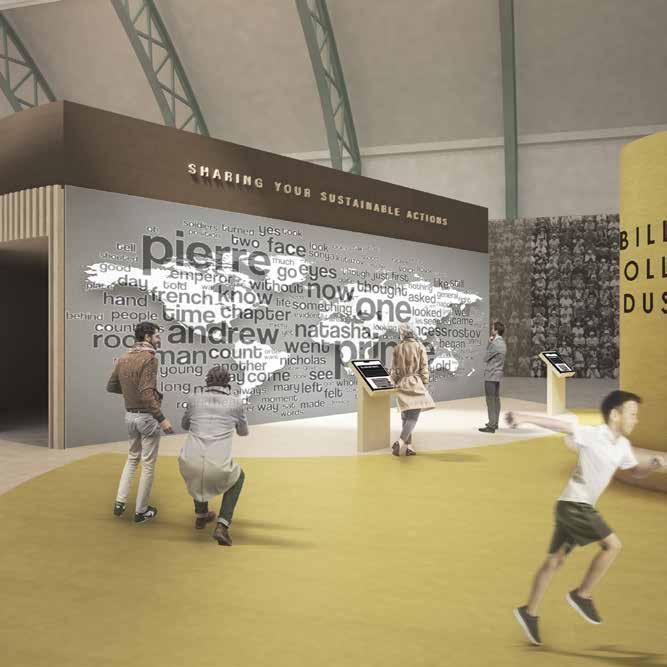
This area consists of a projection room, in which visitors can learn about the case study of a stable in Sweden. The stable is called Lövsta Stuteri, which works in partnership with researchers from Wageningen University in the Netherlands to develop tools capable of measuring CO2 emissions. On the outside wall of the projection room, there is an interactive panel called Sharing Your Sustainable Actions that invites visitors to share sustainable initiatives. The objective is to share information and thus teach and motivate visitors to adopt sustainable practices.
In The Equine-Assisted Therapy: Power & Life area there are two activities, the first is the Equine Therapy Simulator, which consists of five horse simulators arranged radially around a cylinder. Each simulator will be assisted by a therapist. The horse simulator reproduces equine assisted therapy in a more controlled way, providing the visitor with an approximate experience of the therapy. The second activity consists of projecting testimonials from equine therapy patients on a semicircular screen hanging from the ceiling. Through patient testimonials, visitors will learn how relevant and transformative equine therapy is.
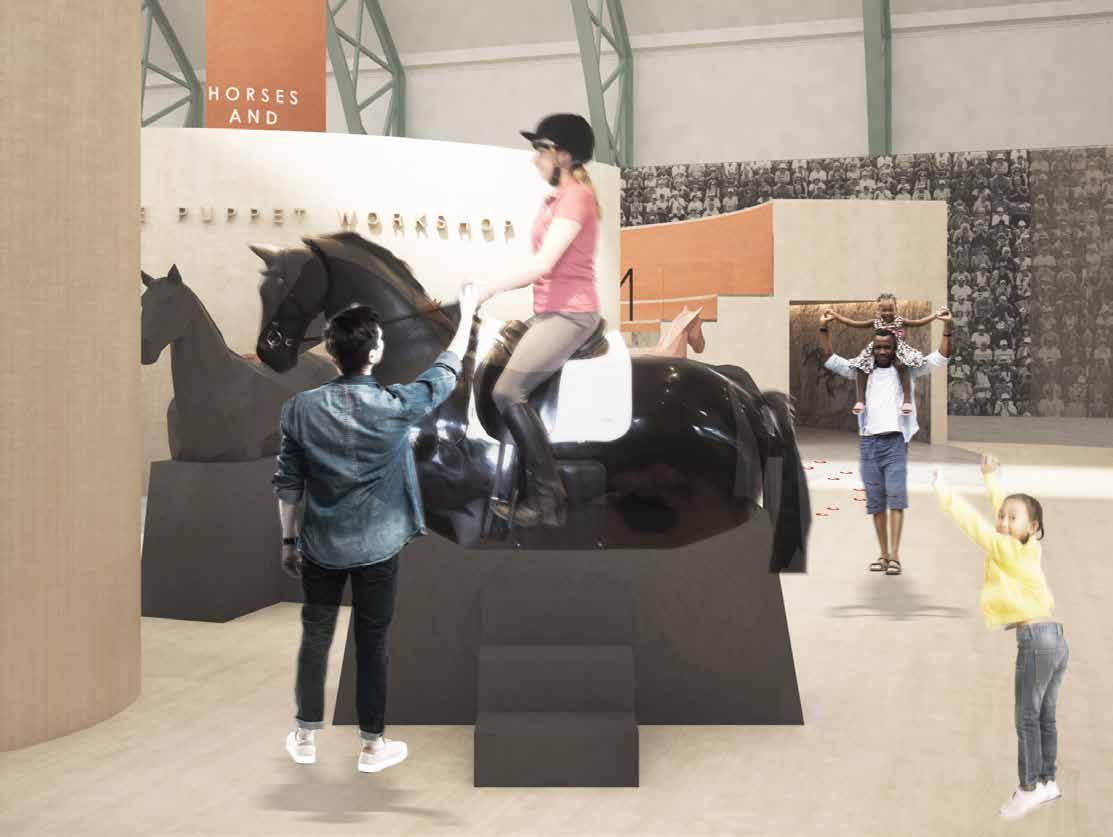
The Equine-Assisted Therapy: Power & Life

Ivar Theorin is a museum professional and has a master's degree in Exhibition and Experience Design from Fashion Institute of Technology.
For the past ten years he has worked at the New York Historical Society, where he leads a team of preparators in fabrication and gallery preparation, annually setting up five to ten large to medium size exhibitions and numerous smaller installations. With a background in Fine Arts, Ivar is looking to combine his experience in fabrication and his artistic abilities in the field of exhibition design.
Ivar's designs are characterized by dynamic use of space and a whimsical touch, always working toward giving visitors engaged and memorable experiences.
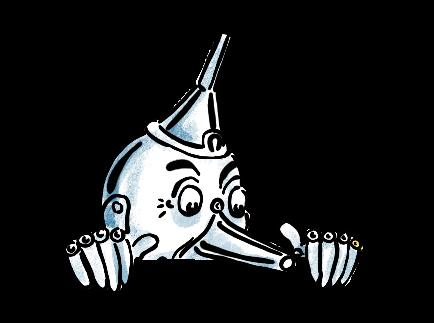
My most vivid exhibition memories are the ones where I felt a sense of awe induced by a physical reaction to the environment while being intellectually inspired by the content. The dark and maze-like exhibition, “Savage Beauty,” which showed the work of fashion designer Alexander McQueen at the Met is the first to come to mind. It had casework towering overhead with dressed mannequins, eerily beautiful and menacing, but also sections where one could get extremely close to observe the details of the clothes. The designers had created a truly memorable experience through a physically imposing environment with a varied rhythm propelling the visitors to explore what lay behind each turn.
I am not even interested in fashion, and I still went to see the exhibition twice.
Another more comforting but equally noteworthy example of an exhibition evoking a sense of awe was Ernesto Neto’s “Anthropodino” at the Park Avenue Armory. A giant structure made from notched pieces of plywood covered in a stretchy translucent material created a cathedral- like interior with many rooms and chambers that took up most of the cavernous drill hall. Stalactite-like bags filled with spices hung from the ceiling and spread warm scents as visitors were invited to gently touch them. The womb-like atmosphere created the sense of being embraced in a giant hug together with all fellow visitors, friends, and strangers alike.
Exhibition design is a unique medium since it requires the visitor to move physically through a space creating an active experience, while most other forms of communication tend to be more passive. The more engaging we can make our exhibition environments, the more efficiently we can communicate our messages. Evoking a sense of awe is an important part of this puzzle as it opens us up to view the world from a new perspective. The two examples above made deliberate use of scale to create a setting that was as much felt in the body as experienced by the mind.
In nature we get a sense of awe from the view of an expansive vista as well as when we lean in to look at the iridescence of the shell of a beetle. In the built environment, on the other hand, we expect everything to be of a human scale and anything that deviates from this norm is likely to cause a disruption.
In the field of exhibitions, we have the opportunity to elicit a sense of awe by implementing elements of Biophilic Design and by having deliberate changes of scale of specific exhibit elements. These interventions will help visitors have a sustained engagement throughout the exhibition, resulting in a memorable experience.
We are all Heroes on our own Journeys
But no one can do it alone
The Wonderful Visit to Oz will give visitors the opportunity to experience the classic literary adventure The Wonderful Wizard of Oz first hand. They will explore the narrative through immersive environments, games and challenges that require collaboration.


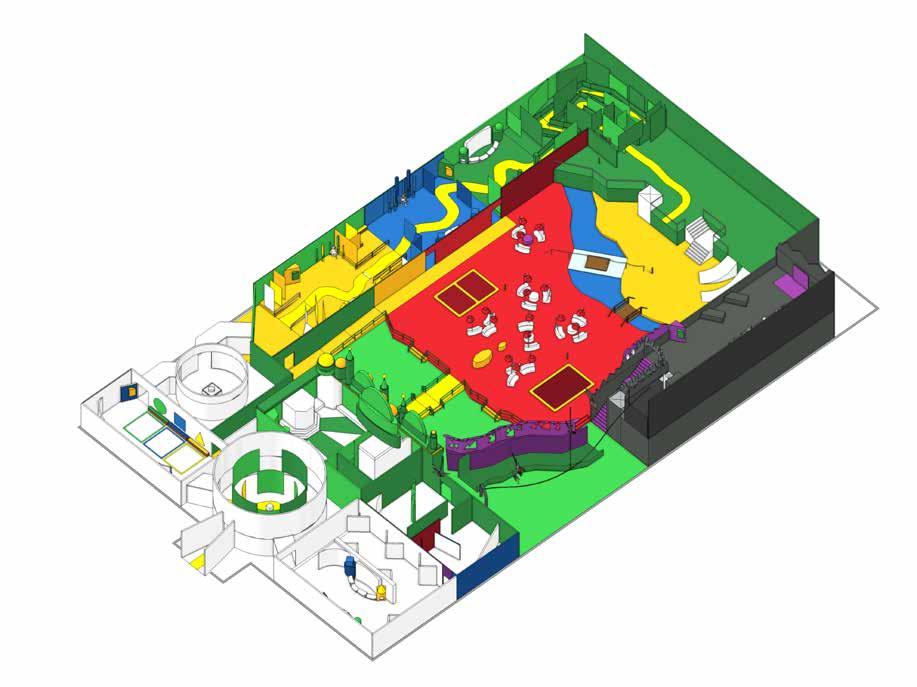
Axon View Scale: 1:300 1
Exhibition Area: 250’ x 155’
Visitors to the exhibition will experience a range of emotions while going through the spaces. The transitions between the environments have been laid out to create a dynamic and engaging rhythm, achieved by using Scale and patterns of Biophilic Design.




Toto's face indicates where to scan RFIDs


Overview
Entrance banners and a yellow brick road floor graphic lead visitors to the check-in area where they receive their RFID bracelets.
The RFID bracelet lets visitors activate the interactives throughout the experience.
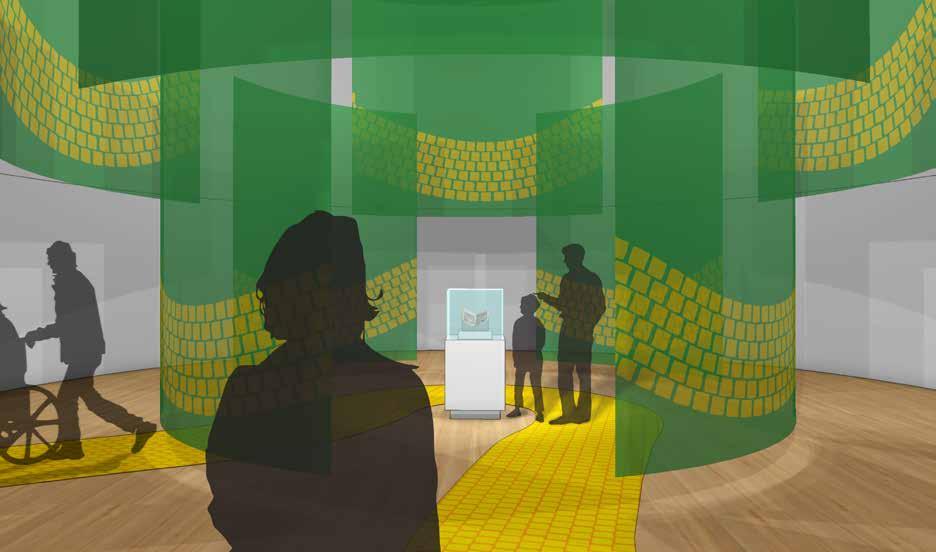
Overview Activities Outcomes
The yellow brick road floor graphic leads into a large circular room displaying a single first edition copy of the book, The Wonderful Wizard of Oz, in the center.
Follow the yellow brick road. Take in the meaning of the book.
Building anticipation and establishing the connection that everything that will follow is based on this small book.

Overview Activities Outcomes
Dorothy welcomes visitors to go on their own adventure. The image of Toto tells visitors where to scan their RFIDs bracelets.
Visitors enter the Cyclone Theater, after Dorothy's introduction, where an immersive projection transports them to Oz.

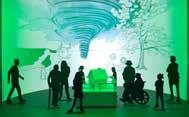
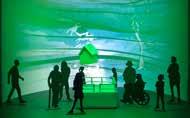

Getting ready for an adventure and feeling transported to a magical land.
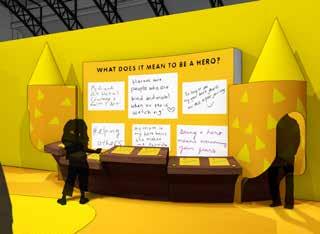
Leave Your Comment Station




Contemplation of the meaning of the Hero's Journey and the Oz Characters. Overview Activities Outcomes
In the Companions Galleries visitors meet the Scarecrow, Tin Woodman, and the Cowardly Lion. They also have the opportunity to reflect on their experience at the Leave Your Comment Stations. Leave comments.
Oil the joints of the Tin Woodman. Pump up the courage of the Cowardly Lion.

From the Overlook there is a vista across the Poppy Field. To proceed visitors have to cross the river on the raft or choose the bridge.
Visitors can choose from a number of activities like crossing the river on the raft, climbing the wall or sitting down under the poppy shaped lights and reading the book.
Visitors create their own adventure before moving on to the Emerald City.




Overview Activities Outcomes
Oz presents the visitors with the quest to defeat the Wicked Witch. On the way they will encounter a Scary Forest and have the chance to face their fear on the Flying Monkey Zip-Line.
Facing fears in the Scary Forest and on the Flying Monkey Zip-Line. Recognizing the significance of the book and how something seemingly small can have a lasting legacy.
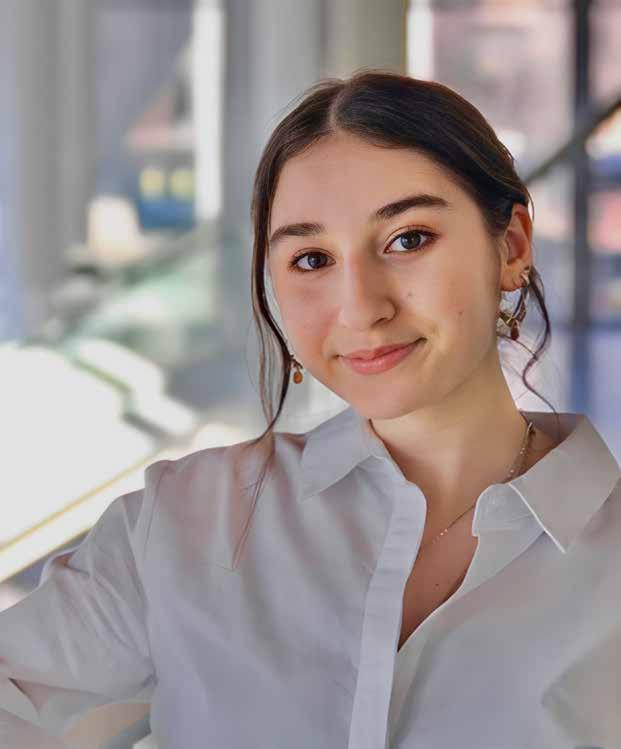
Artist Statement:
Art is the ultimate unifier within a world at odds because there is no language necessary to interpret the arts, it is emotional, it is felt. This empathy translates into all conceptual designs I create, where reaching the audience is at the core of any and every project. I have rooted this narrative in my years studying Sustainable Community Development at the University of Massachusetts, Amherst and Exhibition and Experience Design at the Fashion Institute of Technology in Midtown Manhattan. Through these educational opportunities I have made beautiful connections with the material, as it has helped me grow in my path as a designer, as well as the inspiring peers I met along the way.
Now I would like to share my gratitude with you for exploring my MA Thesis in the art of grounding and I hope you learned how to pause, appreciate, and take a breath because you deserve the feeling of balance with yourself and the world around you.
This exhibition will explore the complexities between humans and nature, uncovering the anatomical and emotional connections we share. There are rich similarities apparent from the mycelium1 network of fungal roots and the neurological networks within our bodies, each orchestrating a communication system for the organism to thrive in their environments. For instance, the mycelial energy centers referred to as “mother trees'; are older trees of the forest ground that have created the foundation of the rooted networks. Therefore, the mother tree can sense when there is a weakening within the rooted connection between younger trees of the forest to send nutrients through the mycelial to aid the ill trees back to health. The human body functions in a similar format, for instance, reaction to making contact with a hot surface, reflexes kick in, and the hand is pulled away or if a disease enters the body the immune system cell soldiers will fight against the foreign bacteria. These systems are significant to the function of life itself and align the thought that humans and nature act in synchronicity.
Earth Within will immerse visitors into the experience through methods of meditation and investigations of the natural elements. The Brooklyn Museum was an optimal location to explore this concept because of its connection to the community and its adjacency to nature zones. The exhibition grounds are in three locations; the glass pavilion of the museum’s lobby, the outdoor lawn, and an extension into the Botanic Gardens. The core elements of the exhibit involve decoding the language between art in nature. The bridge between this dialogue of art and nature is the Lumi Guides. Each Lumi Guide represents one of the natural elements: earth, fire, air, and water. Lumis will define grounding zones for visitors to reflect and process information learned along the experience.
To ground is to align your mind, body and soul. This can be accomplished in many ways depending on the preference of the individual's connection to their sense of self and environment. Although, a universally sound rule of grounding is breathwork. Our breath taps into every part of our being and connects us to our surroundings providing confidence in the present . Before we continue, pause and take a breath and not the typical implicit breath, but an intentional full belly breath, in and out. This is an opportunity to root into the now and clear your mind. Through the art of breath spaces optimal for grounding can be integrated into designed environments to elevate experiences of visitor engagement.
The Earth Within will combine the facets of expressive arts, therapy, cymatics, and somatic breath all woven into the core value of grounding. These researched topics will be explored to elevate the visitor experience through empathic design principles. In relation to the core of my thesis, my goal is to express the profound connection between human existence and nature which surrounds us. Join me on this journey to explore the Earth Within and how Art Opens Our Minds.


The three pillars of grounding are creative visualizations, breathwork, and sound frequencies. Each of these elements connects our senses with the natural environment that surrounds us, and creating fluidity between these senses is key to creating a proper foundation to ground. Once these properties of visualization, breath, and sound are integrated into the theory of design, the viewer will feel an effortless bond with the space they are involved in and initiate a grounding experience.
Subject Brooklyn Museum, City Arts Grounding
Client Venue
Audience
Brooklyn Museum Pavilion, Lawn and Botanical Garden
Students, families, and wanderers



The Earth Within App introduces a way to connect to these programs prior to the installment and then continues to serve as a guide for the Walk with Sages audio tour in the Brooklyn Botanic Garden.

The Arts and Connect program serves as a way to gather community to support the Earth through art. The Arts and Connect program will have multiple workshops leading up to the Earth Within exhibit with respect to the Neuronet build, Art Block murals, breath and body movement therapy as well as activities in the Botanical Garden. This arts program will have a direct connection to local schools to engage with the Brooklyn youth.

The Lumis are a way finding system that will build intrigue as they will be peppered around the city leading up to the Brooklyn Botanical Gardens. Each Lumi represents one of Earth’s elements As in order above, Fire, Water, Earth, and Air.


Earth Within is an exhibition that will remind the visitor of the eternal connection between humanity and the natural environment. Through elements of design, the exhibition will showcase these dynamic relationships such as the visual and functional alignments between the fungal roots of the mycelium and the human body’s neural network. In relation to these synchronicities, the elements (fire, earth, water, and air) are vital to grounding into our present. Interactives and programming of the exhibit space will encourage visitors to tap into their auditory, visual senses through the experience of cymatics, body movement rooted in tai chi, sculptural installations and a walkable audio tour in the botanical gardens adjacent to the Brooklyn Museum.
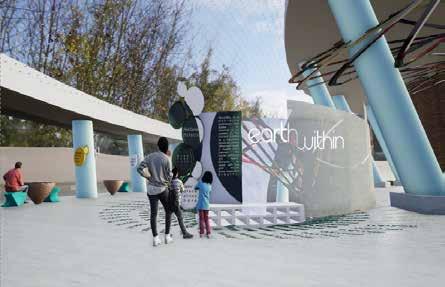
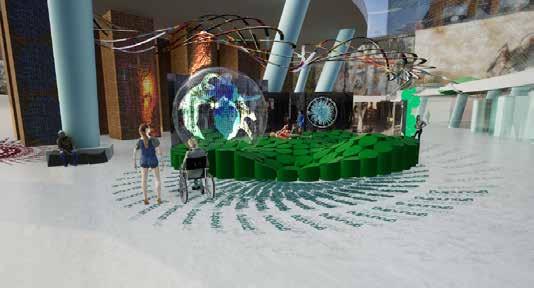



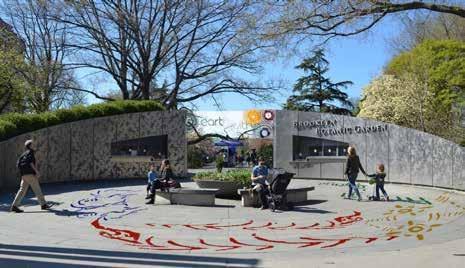
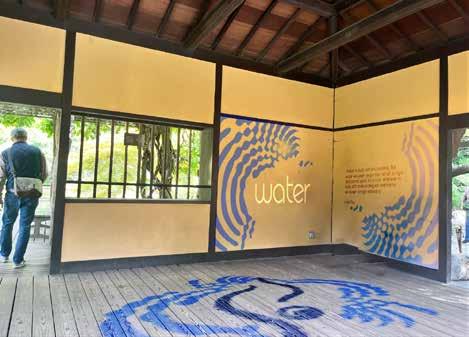
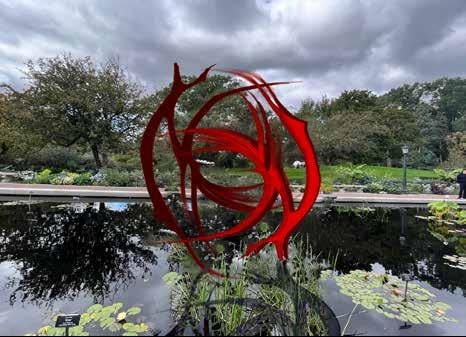




Janine was born and raised in Manila, Philippines. She has work experience in the banking and telecommunication industries, with roles from customer service to product management, and marketing.
With her background in marketing and a degree in interior design, she was very interested in branded environments, as well as the experiential aspect of hospitality, retail, and other commercial design projects. This interest inspired her to pursue a graduate degree in exhibition and experience design. She graduated Summa Cum Laude and was awarded the Interior Design Medal in Spring 2022 at FIT. In the same year, she was granted the Graduate Exhibition and Experience Design Promising Student Scholar award by the EDPA Foundation.
Janine enjoys conceptual development and gets very excited when she nails down the design concept. Her career aspiration is to design meaningful and human-centered interior and experiential spaces.
About 1 in 36 children aged 8 years is estimated to be on the autism spectrum. According to CDC, autism is a developmental disability characterized by persistent impairments in social interaction and the presence of restricted, repetitive patterns of behaviors, interests, or activities that can cause a wide array of difficulties in social interaction, communication, and participation in daily activities.
As a student of exhibition design and a mother to a museumloving kid, I was interested in how cultural institutions are accommodating visitors who are neurodivergent, a nonmedical term which means diverging from the standardized, typically developing norm.
Programs dedicated to autistic children are valuable to them and their families, as well as to the organizations that offer them, because these kids are potentially loyal visitors when they become comfortable with the routine of visiting. With the growing number of cases of autism, being more inclusive could mean reaching a wider and more diverse audience. Museums, especially the ones that cater to children, are experts in experiential learning, and some have been offering accessible programming for families with sensory sensitive children. Thus, museums are uniquely positioned to further support children on the spectrum.
The exhibition project approaches solutions to address this area of opportunity. It is a multisensory experience that will engage children through common interests. It is a space where they are not just accommodated, but also celebrated. While children discover their strengths through play, adults facilitate and guide them and, in the process, understand that what makes these children different can be viewed in a positive light. This approach will help children develop a sense of agency and self-confidence.
Inclusion in museums can extend beyond physical access to accommodating all audiences including the neurodivergent (can include autism, ADHD, learning disabilities, or other neurological or developmental conditions) through events such as early morning sensory-friendly programs. However, these programs are limited as they only happen occasionally and are very focused on accommodating sensory sensitivities, which vary even among neurodivergent visitors.
A multisensory exhibition around common interests can not just accommodate, but engage children across a range of cognitive abilities, while focusing on visitors on the autism spectrum. This approach will increase their self-esteem and help them recognize that their unique abilities make them valued members of society.
The subject for the exhibition is based on the common interest among autistic people in systemizing domains such as machines and technology, information and mechanical systems, and the sciences. A study conducted among a nationally representative sample of young adults in special education suggests that students on the autism spectrum are most likely to pursue STEM (Science, Technology, Engineering, and Mathematics) majors.
The characteristics and behaviors observed in autistic individuals that are viewed as deficits are the same factors that can explain their talents. A study published in a biological science journal concludes that the origins of the association between autism and talent begin at the sensory level, include excellent attention to detail and end with hyper-systemizing.
S uperhero School is not your typical school. It is where kids of diverse cognitive abilities discover and harness their strengths, where they learn that being different is a superpower.
Client New York Hall of Science (NYSCI)
Subject Venue Audience
Science, Technology, Engineering, and Math (STEM)
NYSCI, 47-01 111th St., Queens, NY 11368
Primary: Families and school groups with children on the autism spectrum


Budding superheroes are welcomed to Superhero School with a mission: use their superpowers to help save the earth from climate change.
Super Wristbands powered by RFID technology will allow personalized tracking of results so that children can discover their superpowers at the end of the experience.
While children save the earth, adults learn about neurodiversity and the cognitive abilities of children on the spectrum. This knowledge can help them guide the children in identifying their interests and nurturing their strengths.
The exhibition can be started from either of the opposite entries.
Visitors can choose which STEM areas or games they want to play. They can go in the order they prefer and recharge anytime they need a calming space.
Their superpowers are revealed and reinforced at The Ellipse.

MATH
ENGINEERING
SENSORY THE TOWER

SECONDARY ENTRANCE TECH
ORIENTATION
• MY SUPERPOWER
• SENSORY ROOM
• BETTER WORLD
GALLERY OF INSPIRATION
GRADUATION
SCIENCE
MAIN ENTRANCE
ORIENTATION



different weather conditions.

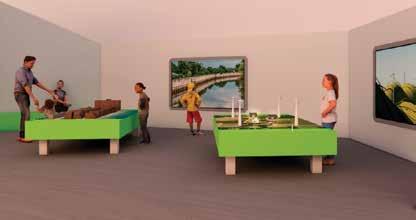
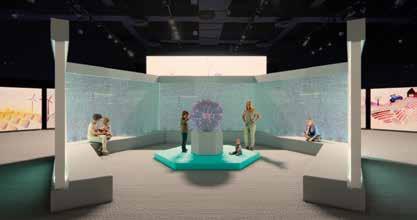
Bubble-walled room with plasma globe at the center where visitors can stay when they feel overwhelmed.

Kids discover their superpowers by scanning their Super Wristband and seeing a projection of their chosen avatar in the corresponding costume.


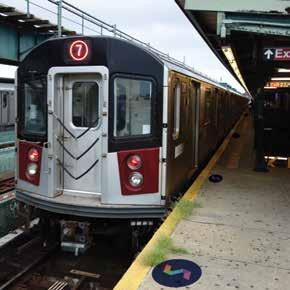

The S of the logo is made into a bat-signal and spread strategically at subway stations with the 7 train line and as projection at the venue's exterior. This S-symbol serves as a wayfinding element and a call to action for the budding superheroes.
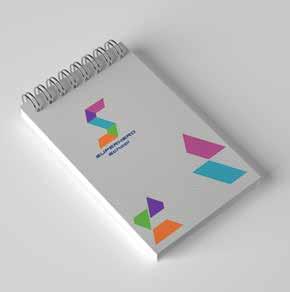

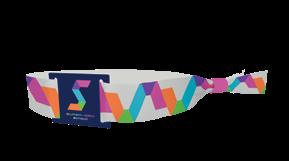

Laura O’Grady is thrilled to have completed her master's degree in Exhibition and Experience Design at the Fashion Institute of Technology in NYC. She holds a BA from Queen’s University in Political Studies and Global Development. Prior to FIT, she worked in communications for her alma mater and a non-profit that facilitates youth learning journeys in the Arctic. Having grown up in Ontario, she loves camping and getting outdoors as much as possible.
Laura loves making new friends and spending time with old ones. She coined the eloquent phrase “friendship mushing” in the summer of 2021 in Ottawa, Ontario when she began initiating tactfully run park gatherings for friends of friends to meet one another. She has a few friendship insecurities, many of which stem from being a bad texter, that drove her interest in this topic. She was curious about what makes a good friend and how exhibitions and experiences can be designed to help visitors maintain the friendships that you have and love.
When people go to exhibitions or designed experiences, they rarely go alone. Furthermore, the companions that people bring to exhibits are not just acquaintances, but loved ones, family and friends, out-of-towners or love interests, all looking to have a unique experience together. Great exhibitions or experiences can be the best part of someone’s day, can be embedded in someone’s memories forever, and can provide the opportunity to strengthen their friendships, therefore enriching their entire lives. Despite often being overlooked in favour of other life priorities, friendship is proven to increase levels of emotional and physical well-being. Friendships are wrongly assumed to always happen naturally, without much intervention, and blame is placed on an individual if they cannot connect with others. However, designers, with their ample creativity and ability to improve the lives of others, have a great opportunity to learn more about the creation and function of friendships, as well as the opportunity to build creative ways that facilitate the creation, strengthening, and maintenance of adult friendships.
To address this opportunity, I propose an exhibition on the subject of sleep. Sleep is universal. I became further confident in my choice of an exhibition on sleep as I mentioned the topic to others. Every person I told expressed a keen interest before launching into a personal story, asking if I remembered to cover a certain component or sharing an idea of their own in connection with sleep. The topic provides a rich array of subtopics and lends itself to the utmost creative interpretation in design and clever programming opportunities. Sleep and friendship are complementary focuses as the improvement of these two areas in an individual’s life has a meaningful impact on quality of life.
The exhibition is called Sleep Factory and is designed to be an immersive, self-guided linear exhibition experience that takes
visitors through several rooms and galleries covering a wide array of components of sleep. The physical spatial design, interactive components, and programming ideas were designed with adult friendship in mind. The exhibition will provide visitors with opportunities to connect with their companions, fellow visitors, and themselves, in hopes of creating a strong basis for connection. This design enables adults to begin new friendships or strengthen and maintain existing friendships.
Sleep Factory is just one example of how an exhibition can harness these techniques in support of adult friendship; however, my learnings apply to all designed experiences and exhibits. This paper serves as a jumping-off point for designers to use their unique way of thinking and creative problem-solving to weave in opportunities in support of friendship creation, maintenance, and strengthening.
Meaningful friendships play an essential role in human well-being in every stage of life. However, as people age, friendship often moves lower on people’s lists of priorities in favour of things like career and family. Studies show this results in increased loneliness in adults today, often labeled a “loneliness epidemic.” Additionally, finding and maintaining friendships in adulthood is increasingly hard as it requires practicing vulnerability, intentionality, making time, openness, and grace. Research shows that many adults attend museum exhibits, experiences, and events due to a social motivation. Designers can harness this intuitive motivation to create spaces that help visitors overcome barriers to friendship creation, maintenance, and strengthening. Design opportunities include: embedding friendship into design goals, creating a convivial space that ensures inclusivity, creating opportunities for social connection, and raising confidence in individual visitors.
S leep Factory is designed to emulate a mysterious factory where what is being built is never fully revealed to visitors. The true function of the factory is to create more sleep for each of the visitors as they move through the spaces. Through this self-guided, behind-the-scenes immersive tour, visitors will explore various areas of the factory’s mysterious functions and learn about sleep along the way.


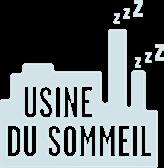
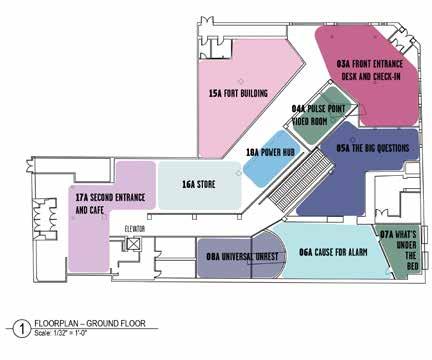

The Sleep Factory will be located in Ottawa, Ontario, in the heart of the bustling tourist attraction Byward Market. Ottawa is the capital of Canada, the home to the country’s Parliament buildings, and is well known for its traditional museums and galleries. Located in the heart of the Byward Market is a large building that previously held a beloved bookstore. This two-floor building is the perfect location, with ample space for an entertaining experience that adds an engaging attraction that contrasts with the surrounding national museums and galleries. The building offers enough space to explore all topics in connection to sleep that are important to cover. Additionally, there is a basement for back-of-house, production materials, and overflow storage to allow for the growth and change of the space over time.
Client Casper Mattresses
Subject Sleep
Venue Repurposed bookstore in Ottawa, Ontario, Canada

Upon entering the Sleep Factory visual cues will guide guests to the beginning of the experience. Staff members in identifiable uniforms will be at pivotal locations to direct folks upon arrival. Visitors will approach the entrance desk to have their tickets scanned and check their shoes and jackets in exchange for bunny slippers and an RFID bracelet. Next, visitors will approach kiosks where they will activate their bracelets and complete a brief questionnaire to sort them into various sleep chronotypes and their bracelet band colour.
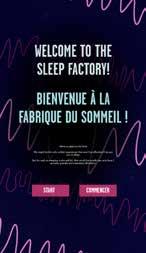


Building on the introductory video’s implication that so much about sleep is unknown, this gallery will explore the history of sleep research, the emerging beliefs scientists have on sleep, and encourage visitors to brainstorm why sleep is happening. This will visually indicate the leading theory that sleep’s primary purpose is to manage all the data and memory’s people absorb during the day.
Activities include testing an EEG brain scan device, turning sleep on and off with a giant light switch, and writing out memories of loved ones and friends that then get “stored.”
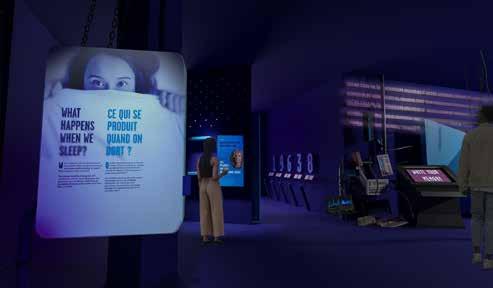

Whether a human is sleep deprived or incredibly well-rested, their health and wellness is impacted significantly. This gallery uses conveyor belts to shape the room into three key areas that focus on how the effects of sleep correlate with (1) physical, (2) emotional and (3) cognitive well-being.
Activities are designed for multiple people or friends and include a driving simulation as sleep quality progressively decreases, a media playback that illustrates emotional perception on various levels of sleep and several cognitive memory and puzzle challenges.
Balancing act. This college student has way to much on their plate. Can visitors stack it all?
Shhh... Sneak by a sleeping baby and new parent. Don't wake them up!
60 seconds on the clock to type, text and phone in responses to a desperate boss and coworkers with poor boundaries.

Once upstairs, the Sleep Walk consists of eight small rooms that are decorated as different environments and bedrooms. The purpose of these rooms at the factory is to study the individual impacts of sleep on different people. Visitors will approach each “case study” room and be faced with a challenge as well as demographic information.
Visitors are tasked with reorganizing this teen’s calendar to fit in their delayed sleep phase syndrome. Spoiler alert, there’s no ideal way without political advocacy for delayed school start times.
For a quiet couple of minutes, visitors are invited to reflect on how the experience of sleep is different for someone experiencing homelessness.
This challenge involves finishing the words to famous children’s stories with information about children sleep habits.
In the final room of the walk, visitors learn about the importance of physical activity for getting good quality sleep, especially in old age.
Visitors will gain empathy for the unique challenges individuals face with sleep including new parents, folks experiencing homelessness, teenagers with Delayed Sleep Phase Syndrome and more.
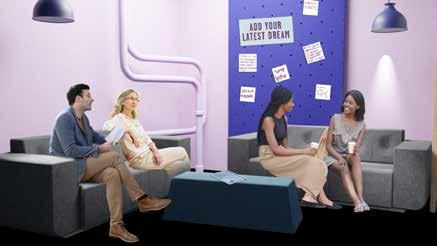

Comfortable, ample seating allows people to really immerse themselves in conversation and discussion when the motivation strikes and reduces fatigue. When friends attending an exhibition can sit and discuss in chairs together their learning is enriched through conversation where they share, challenge, educate and joke together.

and rest space

Great conversation and time together
Jeffrey A. Hall's paper called How many hours to make a friend? had two main takeaways for design. First, friendships form when people spend time together (50+ hours). Second, meaningful conversations (joking around, catching up, and affectionation) were indicators of closeness. Therefore, design should aim for friends to have time together and great conversation.
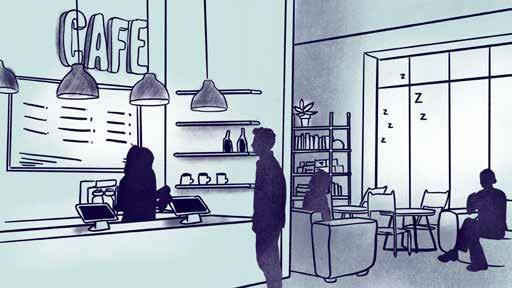

When creating a space designers hope people view as a "third space" (a.k.a. a place they feel comfortable frequently that is not work or school), designers must consider how the space should feel welcoming. This may mean sacrificing exciting design ideas so the emphasis is on the people and conversation. Visitors should feel comfortable spending time here with good friends and interesting conversation.
In this Casper Café, the emphasis is on comfort and simplicity for that very reason. The café also features information about caffeine’s impact on sleep, and for that very reason it does not sell caffeinated coffee after noon.
Designed to make visitors feel at home, the Casper Café is open to all visitors passing through, whether or not they are attending the experience. In this space, there are products available for testing and on display. Additionally, Sleep Factory swag is available for purchase.




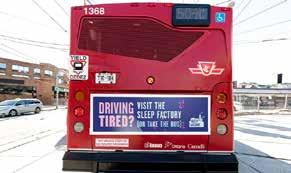




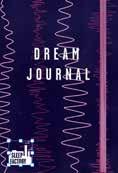




Hi! I am Sonali Agle, a versatile designer hailing from the dynamic city of Mumbai, where dreams come to life.
Armed with a Bachelor’s degree in Visual Communication Design, my professional journey has spanned diverse realms, including branding, packaging, space and installation design, including fabrication.
As a visual learner and keen observer, my creative endeavors draw inspiration from the rich tapestry of life that surrounds me, grounded with my culture. Through my work, I aspire to breathe into these nuanced challenges.
Coming to New York City, a city that has perpetually fueled my creative spirit and stands as a city of my dreams, as a manifestation of my hard work and resilience, to embark on an exciting chapter of my life, pursuing a master’s degree in Exhibition and Experience Design at FIT. Here, I am eager to translate my belief into action, crafting immersive and interactive experiences that engage audiences through narrative building and knowledge dissemination.
Growing up watching arts and crafts shows, Art-Attack and MAD, I would find myself recreating everything in my style. I found the ability to capture a moment while still living in it through live sketching and painting. I was always known as the ‘Artsy’ kid in school and my love for using bold color palettes and typography has ever since manifested into my work.
The theory of color being subjective has always been at the top of my mind, especially because my dad is partially colorblind. Even with this condition, he never let it cause a hindrance in his life, especially because he designs and manufactures Indian wedding mandaps (decors)—there is nothing more vibrant than an Indian wedding! He would sometimes rely on us to interpret certain colors to him if he was confused with the shades, and the way we would describe them to him was associating the color with our everyday life. For example, we would relate shades of maroon and magenta to that of a glass of red wine.
My personal experience of perceiving color through my family and friends has significantly influenced my professional work. From the very beginning I was certain that I would like to focus my research on the human perception of color because it is a visual phenomena that has such a massive impact on our everyday lives. Yet, color is experienced differently. However, we all share a common understanding of it.
This proposed experience bridges the gap between design and education by curating an event that welcomes visitors to engage in a variety of activities put together through the applied use of this thesis.
‘Symphony of colors’ is designed to celebrate the colors of our lives through music, dance and immersive collaborative activities with PANTONE and Apple Music.
These activities will further engage the visitors to explore their personal relationships with color and how colors can be used as an effective tool of communication and the emotional depth they carry with them. Visitors will be able to reflect upon their experience through interpretive prompts and take away with them how color can be subjective. At the same time, the experience shares with the audience an educational and creative opportunity to reflect upon being grateful to see and experience the beauty of this world subjected to us through the lens of someone who unfortunately can’t. The phenomenon of synesthesia will be explored through the process of gamification on interactive screens and live concerts with renowned artists who have synesthesia.
The importance of color in our everyday lives cannot be understated. Color plays a pivotal role in various aspects of human perception, communication, experience, and cultural expressions.
Color is one of the constants in our lives. We learn, work, live, and sometimes even dream in color.
This in turn, raises the question - Is color accessible to everyone?
Effective color accessible experience plays a crucial role in creating inclusive and user-friendly environments by prioritizing color choices, contrast, and alternative design elements, thereby enhancing accessibility and ensuring equal participation for individuals with visual impairments or color vision deficiencies.
H uman perception of color is subjective. It can be experienced together through a multidisciplinary approach, combining knowledge from different fields, influences that shape our perception and experience of color.
Symphony of Colors will also explore synesthesia, a neurological condition in which things experienced through one sense produce a sensation in another.
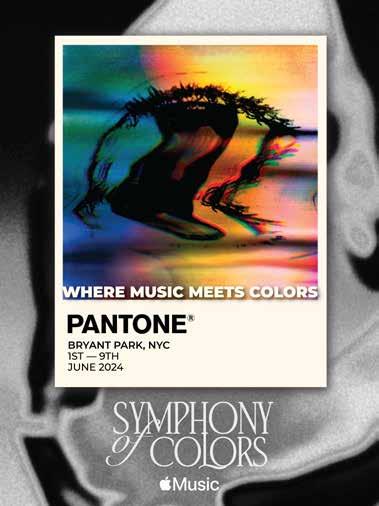

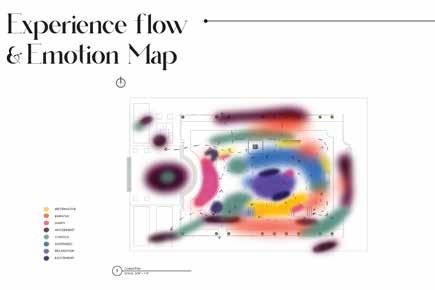
PANTONE X Apple Music
Human perception of color and color accessibility
Bryant Park, NYC
Primary: Creatives, Apple music users, and students
Secondary: Tourists and locals
Tertiary: People with synesthesia




3 days prior the main event, on 29th of May 2024, pre-activation events will begin. PANTONE and Apple Music will post a series of stories and promotional posts on their social media accounts to drive the visitors outside every Apple store in New York City.
These kiosks will act as an extension of one of the activities at Symphony of Colors and invite visitors to relate their favorite color with a song of their choice and send it to the next person. Upon completion of this activity they will receive a virtual pass on their mobile device and emails.
Several posters of Symphony of Colors will be placed around the city which would be revealed by taking away a piece of it that will give information about the location and dates
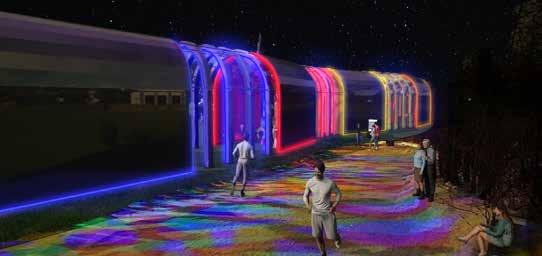




SEE: Whimsical dichroic tunnels, with welcoming introductory graphics and multiple entrances.
DO: Visitors will step into these monochromatic zones of red, blue, yellow and orange to explore and experience the emotional depth of colors.
LEARN: How colors influence our daily lives and set our moods, and evoke emotions.
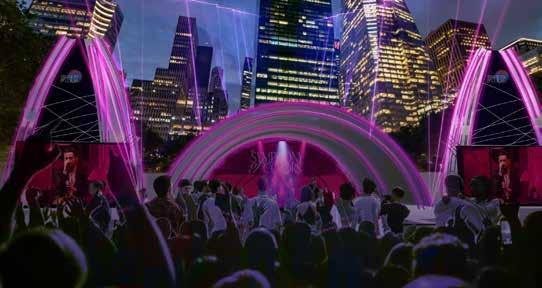
SEE: A musical concert stage

DO: A series of musical events will be hosted throughout the duration of this event featuring some notable artists from the industry who also experience synesthesia.
LEARN: Visitors will learn about the relativity of colors with emotions through music in this experience.

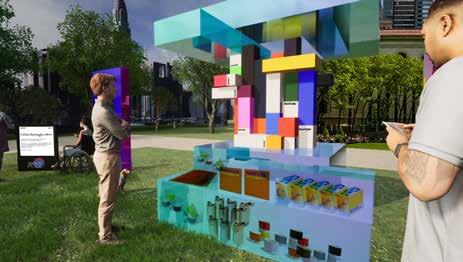
SEE: House of PANTONE with an interactive installation of PANTONE shade cards and various merchandise on display.
DO: Visitors will be involved into a bunch of activities in this area—one can chose what PANTONE shade describes them the best and have it displayed on the interactive screen, custom make their own PANTONE shade card and take it away with them and take a look at their products which they can purchase.
LEARN: Visitors will be introduced to PANTONE, where they will learn how they set the coloring standards of the world and get briefly introduced to their brand studies.

SEE: Multiple interactive arches scattered around the park.
DO: Curate a community playlist with Apple Music influenced by their favorite color, relating it to the music of their choice.
LEARN: How different people experience the same colors through a varied genre of music.
Gain knowledge about Chromesthesia—a type of synesthesia where you hear colors.
SEE: Pantone installations, white Rubik’s cube and a wall of ivory ice creams.
DO: Visitors will embark on the journey of experiencing colors through their other senses, devoid of any visual cues and reflect upon how colors actually feel to them.
LEARN: How human perception of color is subjective and how colors can be used an effective tool of communication.


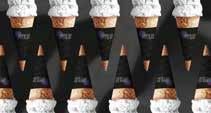
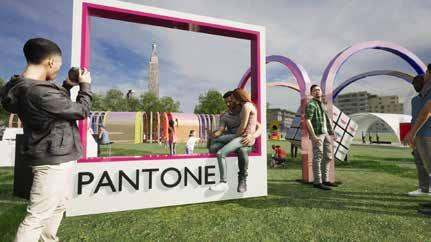



Some memories are meant to be shared
SEE: Arch shaped installations with interactive screens and play disks.
DO: Play multi-player games with the community and interact with the installation.
LEARN: Visitors will learn about synesthesia through various interactive games.







Wan-Ting Lin, born and raised in Taiwan, is a dedicated spatial designer passionate about shaping immersive environments that leave a lasting impact. She studied Landscape Architecture Design at Tunghai University in Taiwan, where she discovered her love for creating meaningful connections between people and spaces.
To explore a more narrative approach in design, she pursued studies in exhibition and experience design at the Fashion Institute of Technology in New York. Throughout her academic journey, Ting delved into the principles of experiential design, exploring the ways in which design influences human interactions. This exploration led her to focus her thesis on the transformative potential of experiential design in various contexts.
In our world, people put a lot of effort into designing products to help people with color blindness fit into our society, such as color blind glasses. However, most colorblind people feel it is an uncomfortable situation. Andy Balo, a color blind person said, "Why do color blind people have to purchase expensive glasses in order to function in the world when the designers could make very minor changes that make a huge difference for a whole lot of people?" As a designer, I took this perspective to start working on my thesis and exhibition project.
To create a more inclusive environment for our society, I researched empathy thinking design, one of the industry's important design tools. It helps designers create a solution based on users' situations and allows the audience to see the world through other people's eyes. Also, when designers adopt this type of design, they can get closer to understanding the users' wants, needs, and perspectives.
The exhibition project provides an opportunity for the public to experience what people with color blindness face in their daily lives through diverse materials, mediums, and lighting. In addition, friends and family of color blind people will have a physical place in which to picture the situations of their loved ones, which guides them to learn what kinds of colors might be confusing in their vision. During the exhibition’s experiences, the color perception and recognition of visitors will be challenged, which will spark their empathy to be built step-by-step. Furthermore, the exhibition will offer color blind glasses to ensure that people with color blindness will not have any problem with color perception. Moreover, it guides some people to realize they might have color blindness, and they can use the app to do the color blind test.
The integration of the thesis and the application of the project encourages the audience to consider individuals with color blindness after experiencing the exhibition. It fosters social awareness of color blindness among the public and inspires the design industry to create spaces where everyone feels welcomed.
Inclusivity considerations play a significant role in current principles for the design industry, and designers try to consider how to create spaces where all feel welcomed. Color is an important element in conveying information in spatial design, however, it is hard for people with color blindness to distinguish colors because most systems are designed for people who can discriminate color normally. By understanding color blind perspectives, the designers can take advantage of diverse material and lighting to create more inclusive, educational, and empathybuilding exhibitions.

S hades of Empathy is an interactive, experiential exhibition that aims to use a variety of materials, mediums, and lighting effects to bring the audience into the world of color blindness. It also stimulates the audience's curiosity about color blindness through diverse

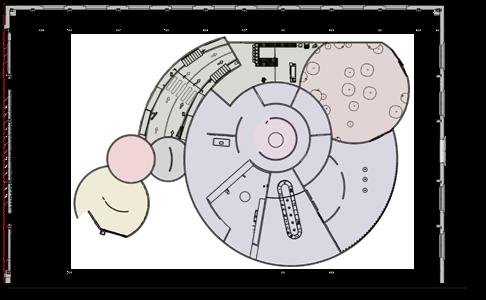
01A Entry
02A What is color blindness 03A What do you see 04A Between us
Powerhouse Arts, EnChroma, and Exploratorium
Uncovering the little known challenges and differences in the daily life of someone with color blindness
Powerhouse, Brooklyn NY
Primary: Experience seekers
Secondary: Family and friends of those are color-blind
Tertiary: Professional hobbyists
Role Play | Interactive Experience
Role-playing is a comprehensive, creative and interactive method that allows the audience to view the world from a color blind people's perspective through the exchange of roles.
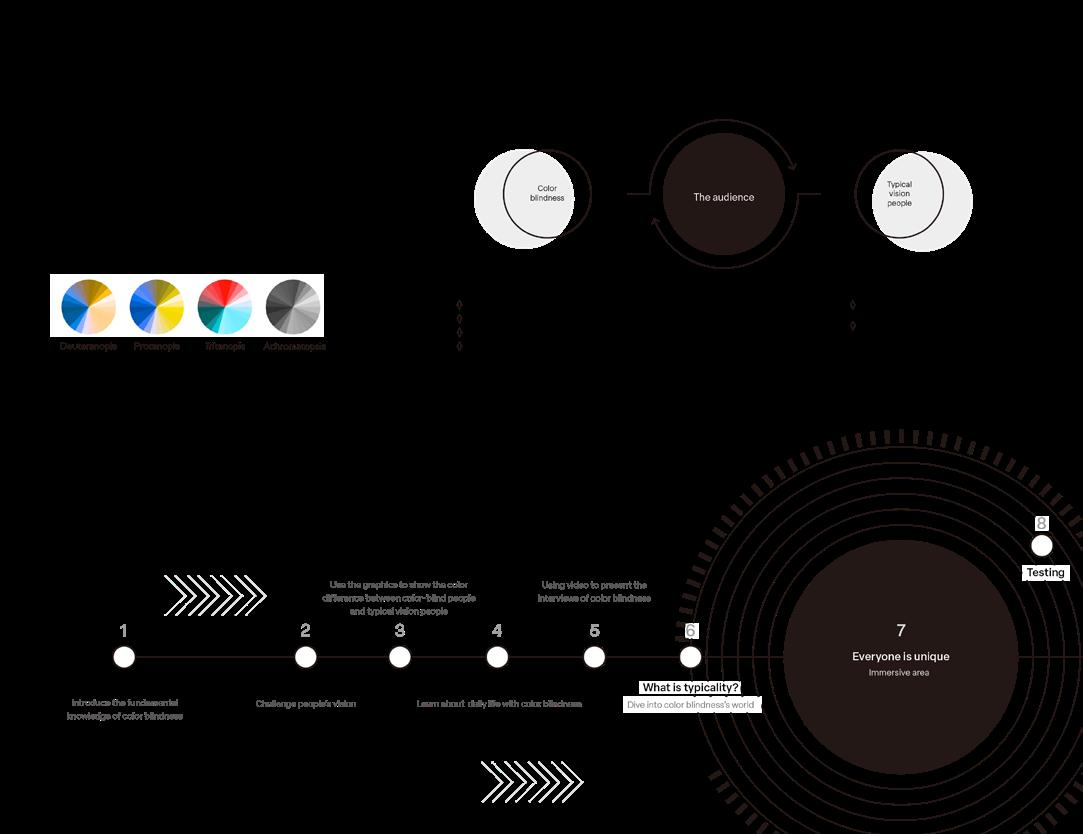
The experience allows the audience to have great fun and to discover:
How the world looks with color deficiency
How materials and lighting influence the way color blind people perceive the world
How to empathize with different perspectives
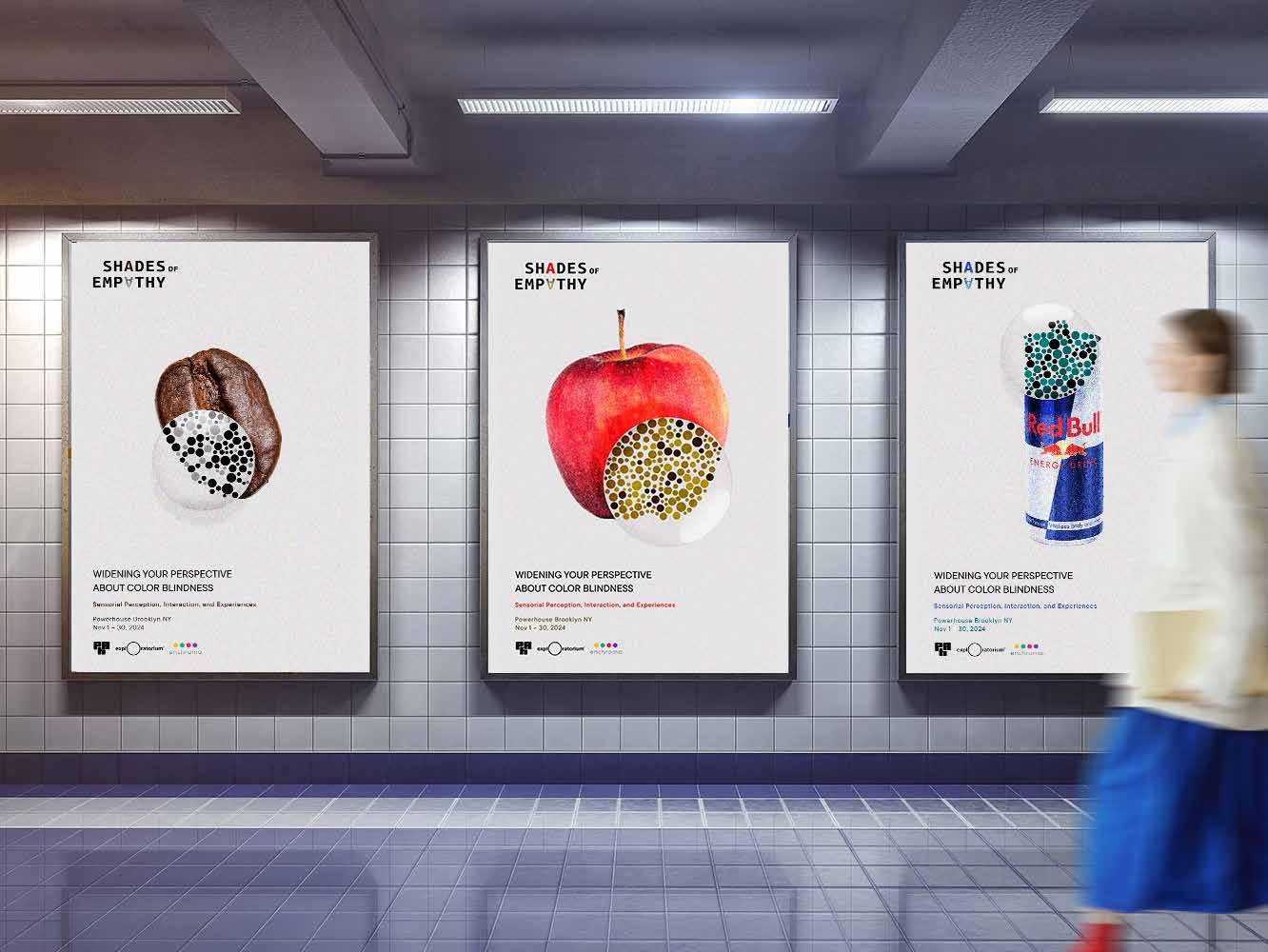
In these stages, the exhibition will present various visual comparisons between typical vision and color blind people.

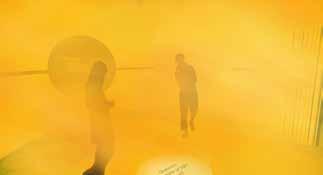



• The videos show what challenges people with color blindness face in their daily life.
• Visitors will activate different stories of color blind people through the guidelines with props.


The audience will experience various scenarios to put themselves in color-blind people's shoes.




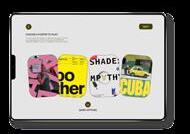



• This room displays various colors of giant apples.
• The ambient light will be changed by timers, and people observe the effect on the apples.
• There are different materials and colors to impact the audience’s recognition.
• People can communicate with each other about their perception of colors based on personal differences in color perception.
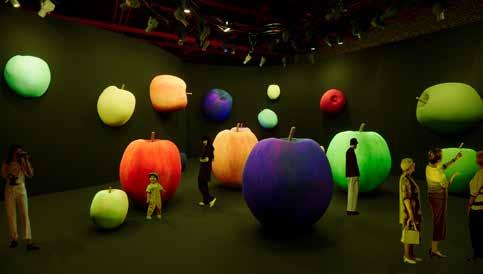






• After completing all areas, people can use the QR code to do the test and check if they are color blind.
• People can upload their photos to create a color blindness test image and post it on social media.

